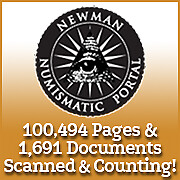
About UsThe Numismatic Bibliomania Society is a non-profit organization devoted to the study and enjoyment of numismatic literature. For more information please see our web site at coinbooks.org SubscriptionsThose wishing to become new E-Sylum subscribers (or wishing to Unsubscribe) can go to the following web page link MembershipThere is a membership application available on the web site Membership Application To join, print the application and return it with your check to the address printed on the application. Membership is only $20 to addresses in the U.S., $25 for First Class mail, and $30 elsewhere. For those without web access, write to: Terry White, Treasurer AsylumFor Asylum mailing address changes and other membership questions, contact Terry at this email address: terrywhite5475@yahoo.com SubmissionsTo submit items for publication in The E-Sylum, just Reply to this message, or write to the Editor at this address: whomren@gmail.com
BUY THE BOOK BEFORE THE COIN |
- WAYNE'S WORDS: THE E-SYLUM JANUARY 24, 2016
- BALDWIN'S FIXED PRICE LIST WINTER 2015-16
- NEW BOOK: COLLECTING COINS IN RETIREMENT
- NEW BOOK: COINS OF THE FRANKISH OCCUPATION OF GREECE
- NEW BOOK: ECUADORIAN COINS - AN ANNOTATED CHECKLIST
- NEW BOOK: MONEY
- NEWMAN PORTAL SCANS MANUSCRIPTS ON CONNECTICUT COPPERS
- PNG CALLS FOR 2016 AWARD NOMINATIONS
- VIRGIL BRAND ESTATE TOKENS AND MEDALS FOUND
- DONN PEARLMAN ON THE WALTON NICKEL RE-DISCOVERY
- NOTES FROM E-SYLUM READERS: JANUARY 24, 2016
- MORE ON THE SKYLAB PLASTER MODELS
- JAMES "NORMAN" SHULTZ (1893-1988)
- PREDICTING THE NUMISMATIC FUTURE
- SIGNS OF RESTORATION AT OLD SAN FRANCISCO MINT
- DAVISSONS AUCTION 35 CLOSES FEBRUARY 3, 2016
- GOLDBERGS OFFER MONEY OF THE BIBLE COLLECTION
- THE TOM REYNOLDS COLLECTION PART I
- SELECTIONS FROM THE POGUE COLLECTION, PART III
- DNW TO AUCTION RARE EDWARD VIII FANTASY COINS
- WAYNE'S NUMISMATIC DIARY: JANUARY 24, 2016
- MORE ON LOTTERIES IN COLONIAL AMERICA
- THE NUMISMATICS OF PROFESSIONAL BOXING
- 1916 IRISH EASTER RISING ANNIVERSARY MEDAL SOLD
- STRANGE ERROR: ROOSEVELT DIME STRUCK ON A NAIL
- POET ROBERT BURNS ON SCOTLAND’S FIRST POLYMER BANKNOTE
- VIETNAMESE BUY SPECIAL BANKNOTES FOR TET
- BIBLIOGRAPHY WEEK 2016
- CHANGING ROLE OF LIBRARIANS IN THE INTERNET AGE
- THE CALIFORNIA GOLD RUSH BEGAN JANUARY 24, 1848
- FEATURED WEB SITE: INTERNATIONAL BANK NOTE SOCIETY
Click here to access the complete archive
To comment or submit articles, reply to whomren@gmail.com
WAYNE'S WORDS: THE E-SYLUM JANUARY 24, 2016

New subscribers this week include: Marcy Gibbel courtesy of Ed Reiter. We now have 1,925 subscribers.
This week we open with numismatic literature in a new fixed price list from Baldwin's, three new books, and newly digitized references on Connecticut Coppers from the Newman Numismatic Portal.
Other topics include newly-rediscovered tokens and medals from the Virgil Brand estate, the rediscovered of the Walton 1913 Liberty Nickel, coin and medal artists' plaster models, the old San Francisco Mint, Norman Shultz, Edward VIII fantasy coins, and the numismatics of professional boxing.
To learn more about Brockett's Essay on Counterfeit Coins and Medals, Dr. Thomas Hall, famous farmer numismatists, predicting the numismatic future, Bibliography Week, and special Lunar New Year gift notes, read on. Have a great week, everyone!
Wayne Homren
Editor, The E-Sylum
BALDWIN'S FIXED PRICE LIST WINTER 2015-16
Item NB001: Brockett's Essay on Counterfeit Coins and Medals
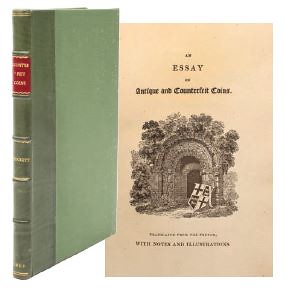 Brockett, John Trotter. An Essay on the Means of Distinguishing
Antique, From Counterfeit, Coins and Medals. Translated
from the French of M. Beauvais; with Notes and Illustrations.
Newcastle, 1819. Octavo, pp. engraved vignette on title page,
94, errata slip bound in at end. Neatly bound in half green calf
and matching cloth boards. Raised bands, red morocco title
label, lettered in gilt, top edge gilt. Some spotting to boards,
contents clean, bright and in a high state of preservation.
Limited to 205 copies. Fine overall. An attractive and charming
volume, seldom offered. £180
Brockett, John Trotter. An Essay on the Means of Distinguishing
Antique, From Counterfeit, Coins and Medals. Translated
from the French of M. Beauvais; with Notes and Illustrations.
Newcastle, 1819. Octavo, pp. engraved vignette on title page,
94, errata slip bound in at end. Neatly bound in half green calf
and matching cloth boards. Raised bands, red morocco title
label, lettered in gilt, top edge gilt. Some spotting to boards,
contents clean, bright and in a high state of preservation.
Limited to 205 copies. Fine overall. An attractive and charming
volume, seldom offered. £180
Item NB004: Evans, Coins of the Ancient Britons
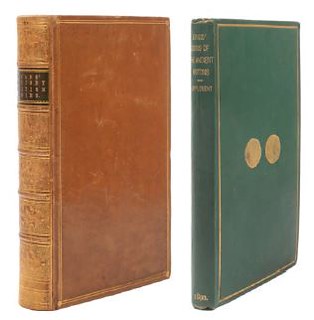 Evans, J. The Coins of the Ancient Britons. London, 1864. Two volumes complete. Quarto, pp. xi, (1),
424, 8+17 fine plates engraved by F. W. Fairholt. Beautifully bound by J. B. Hawes of Cambridge in
full tan calf, double gilt fillets with gilt floral decoration in each corner. Raised bands, black morocco
title label lettered in gilt in one compartment, intricate gilt decoration in remaining. Edges gilt, inner
dentelles blind embossed, page edges marbled. With; Supplement. London, 1890. Quarto, pp. viii,
folding map printed in red and black, (417)-599, (1), 10 finely engraved plates. In the original green
cloth, ruled and lettered in gilt. Gilt embossed image of a Gallo-Belgic stater on the front board. Minimal
wear to extremities, otherwise both volumes in fine condition, each with a neat, engraved bookplate
and Spink & Son book label on front pastedown. A most attractive set, the foundation work to Celtic coins,
rarely seen in such fine condition as here and with the rarely seen supplement. Extremely fine. £750
Evans, J. The Coins of the Ancient Britons. London, 1864. Two volumes complete. Quarto, pp. xi, (1),
424, 8+17 fine plates engraved by F. W. Fairholt. Beautifully bound by J. B. Hawes of Cambridge in
full tan calf, double gilt fillets with gilt floral decoration in each corner. Raised bands, black morocco
title label lettered in gilt in one compartment, intricate gilt decoration in remaining. Edges gilt, inner
dentelles blind embossed, page edges marbled. With; Supplement. London, 1890. Quarto, pp. viii,
folding map printed in red and black, (417)-599, (1), 10 finely engraved plates. In the original green
cloth, ruled and lettered in gilt. Gilt embossed image of a Gallo-Belgic stater on the front board. Minimal
wear to extremities, otherwise both volumes in fine condition, each with a neat, engraved bookplate
and Spink & Son book label on front pastedown. A most attractive set, the foundation work to Celtic coins,
rarely seen in such fine condition as here and with the rarely seen supplement. Extremely fine. £750
Item NB015: Lowndes Report on Silver Coins
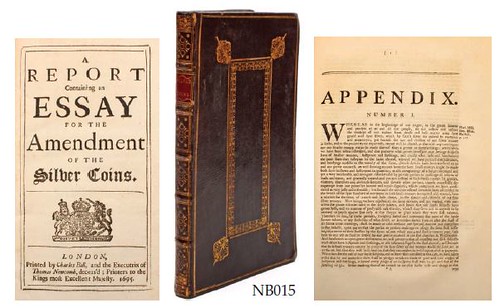
Lowndes, W. A Report Containing an Essay for the Amendment of the Silver Coins. London, Printed by Charles Bill, and the Executrix of Thomas Newcomb, deceas’d; Printers to the Kings most Excellent Majesty. 1695. Quarto, pp. 159, (1), woodcut decorative initials throughout. Elegantly bound in contemporary full black calf, ruled and decorated in gilt, gilt flourishes. Raised bands, red morocco label to spine, gilt decoration in compartments. Marbled endpapers. A very fine copy of Lowndes best known and key work in a beautiful contemporary binding. £1,650
William Lowndes (1652–1724) was Secretary to the Treasury of Great Britain under King William III and Queen Anne, and a Member of Parliament under William, Anne and George I. Known as ‘Ways and Means Lowndes’ he served on the Committee of Ways and Means and wrote this title the year he become Treasurer. In it he called upon the help of Isaac Newton (then Master of the Royal Mint) to help solve the many problems then prevalent with the English currency. Subsequent to Lowndes’ treatise, the Great Recoinage of 1696 was commenced which resulted in the establishment of the provincial mints; Bristol. Chester, Exeter, Norwich and York. See also Manville Vol. III, p 15, “Mr Lowndes has written in so peculiar & instructive a manner, that our Historians may learn better, by his little
Item NB039: Wheeler Catalogue of Saxon and English Coins
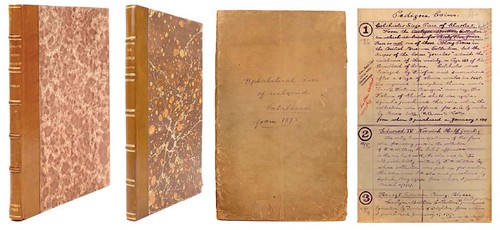
[Sotheby & Co.] Catalogue of the Important Collection of Saxon and English Coins, the Property of G. H. Wheeler, Esq. London, 12th March, 1930. Quarto, pp. 94, 599 lots; 16 extremely fine plates. With a printed list of prices and buyers names bound in at end. The lots acquired by Lockett neatly underlined in red as was his custom and with further pencil annotations to some of the plates. With; Manuscript notebook detailing the contents of much of Wheeler’s collection dated between 1916 and 1925 and giving information on provenance, date and place of purchase, price paid and additional notes. Also enclosed is a running receipt of his purchases (totalling £8608-7-9) which tallies with a manuscript list at the back of the notebook which includes place of purchase and date, a note giving his cost code and a smaller booklet of manuscript notes. An alphabetical list of auction catalogues from 1873 is also present. Both booklets in later, custom made slipcase of quarter tan calf and marbled board, raised bands, gilt lettering to spine. The catalogue rebound in the same. A fascinating compilation of notes revealing much valuable information and certainly worthy of further research. £3,950
M&R Vol. I, p. 252; Manville Vol. IV, p. 309. Ernest Henry Wheeler (1876-1933) was a successful businessman who ran his own highly successful Newsagents, Stationers and Printers based on the Caledonian Road. The notebooks above have been compiled on his own products and are complete with his business address label on the inside cover. He was an aggressive buyer at many of the high profile auctions of the time including Montagu and Murdoch, Ready, Walters, Marsham, Roth and Carlyon-Britton to name but a few. He would bid directly rather than through an agent and as such was well known for paying far more than the market value of the time, a fact which infuriated much of the trade, in particular Cyril Lockett who as a result, and along with many other collectors and dealers, refused to participate in this sale, despite there being many pieces which Lockett would have wanted for his collection. Consequently the sale was not as successful as it perhaps should have been, fetching only £4283-10-0, almost half that Wheeler had paid. Lockett did however acquire some pieces through Baldwin’s after the sale and it is these lots which have been underlined in the above auction catalogue. Lockett’s dislike of Wheeler was well known and it is interesting that his bookplate, usually found in all of his catalogues, is absent from the one here. After the disappointing result of this auction Wheeler chose to sell the second half of his collection directly to Seaby’s who sold it over a number of lists throughout 1930 and 1931. A final selection of coins, discovered after Wheeler’s death in 1933, were sold by Glendining’s in a single lot in December 1938.
To read the complete fixed price list, see:
www.baldwin.co.uk/fixedpricelist2016/

NEW BOOK: COLLECTING COINS IN RETIREMENT
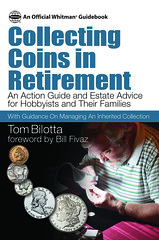 Whitman Publishing announces the release of Collecting Coins in Retirement: An Action Guide and Estate Advice for Hobbyists and Their Families, by Tom Bilotta. The 256-page softcover book will debut March 3, 2016, available from booksellers and hobby shops nationwide and online (including at www.Whitman.com), for $19.95. It can also be borrowed for free as a benefit of membership in the American Numismatic Association, through the Dwight N. Manley Numismatic Library.
Whitman Publishing announces the release of Collecting Coins in Retirement: An Action Guide and Estate Advice for Hobbyists and Their Families, by Tom Bilotta. The 256-page softcover book will debut March 3, 2016, available from booksellers and hobby shops nationwide and online (including at www.Whitman.com), for $19.95. It can also be borrowed for free as a benefit of membership in the American Numismatic Association, through the Dwight N. Manley Numismatic Library.
“Coin collecting during retirement poses special challenges and offers unique opportunities,” says professional numismatist Tom Bilotta, an award-winning developer of software for coin collectors. For more than 20 years Bilotta has worked closely with retirement-age hobbyists, giving him a firm understanding of their wants and needs. Now he shares his insight in this valuable step-by-step guidebook.
Collecting Coins in Retirement coaches the longtime collector toward increased enjoyment of the hobby and smart planning for the future. It helps collectors’ family members understand numismatics and lays the foundation for wise management of an inherited coin collection, whether they choose to maintain or even build upon it, or sell all or some of it.
Coin collectors will learn: Why coin collecting is different in retirement ● How to devise a collecting strategy that works for you ● Ways to define your hobby objectives and consolidate your collection ● When, where, and how to sell your coins ● Important information to share with your family ● How to prepare your estate ● Ways to allocate your collection to heirs
Family members will learn: The issues involved in managing an inheritance ● The best ways to profit from an inherited coin collection ● Strategies for selling different parts of a collection ● Probate and tax considerations
Collecting Coins in Retirement also explains coin-industry trends of recent decades; how to sell on eBay for pleasure and profit; using technology as part of the hobby; and more.
Educator and past ANA governor Bill Fivaz calls the book “well thought out and presented, logical, and user-friendly,” and says that “Collecting Coins in Retirement is a must-read for hobbyists and their families.” Kenneth Bressett, senior editor of the Guide Book of United States Coins, notes that “Those who actively participate in some absorbing activity nearly all live longer, happier lives. And it is never too late for anyone to begin enjoying hobby benefits.”
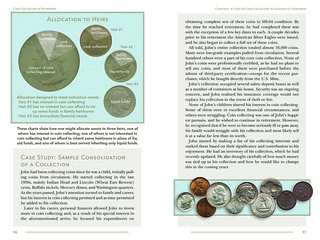

Samples pages; author Tom Bilotta
Collecting Coins in Retirement: An Action Guide and Estate Advice for Hobbyists and Their Families
By Tom Bilotta; forewords by Bill Fivaz and Kenneth Bressett.
ISBN 0794843778.
Softcover, 6 x 9 inches, 256 pages, full color. Retail $19.95 U.S.
For more information, or to order, see:
Collecting Coins in Retirement
(www.whitman.com/store/Inventory/Detail/Collecting-Coins-in-Retirement+0794843778)
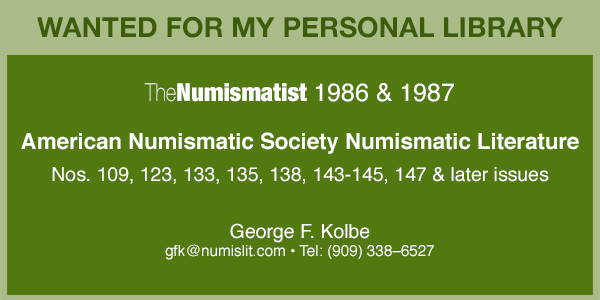
NEW BOOK: COINS OF THE FRANKISH OCCUPATION OF GREECE
This month we present the English translation of the book of A. Tzamalis on the Frankish and Venetian coins of Medieval Greece You can place orders using the PayPal links below or by email at demmath@hotmail.com
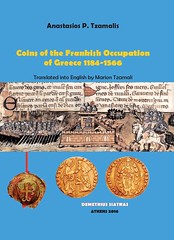 Anastasios A. Tzamalis
Anastasios A. Tzamalis
Coins of the Frankish Occupation of Greece 1184-1566
With a Foreword by D.M. Metcalf.
Athens, 2016. In english.
Soft cover, 29 cm, 320 pp., ill.; net weight 1030 gr.
ISBN 978-618-81118-1-3.
EUR 60.00 + Shipping cost EUR 18.00/29.00
Gustave Schlumberger was a dyed-in-the-wool coin collector. With a keen eye he sifted through the cartons of accumulated coins of the brocanteurs and sellers of antiquities, picking out any varieties that were not already known to him. Eventually his passion and commitment found their full expression in his great work, Numismatique de l'Orient Latin. The varieties were set into the context of what the history books said about the dynasties which ruled during (for example) the Frankish occupation of Greece. Each coin was read as a miniature document: the contribution it made was by its legend, giving the name of the ruler, and the political entity which he governed. That was how numismatists in the nineteenth century understood their chosen task.
There were some basic flaws or weaknesses in this approach. In particular, a variety might have been used for a short or a long time; and the differences between one variety and the next might be historically significant, or they might be merely a whim of the die-cutter or a historically meaningless variation.
Tasos Tzamalis, a hundred years later, had at his fingertips a far richer and more sophisticated methodology, which had been evolved and tested by generations of mediaeval numismatists. Coins were still — are still — necessarily categorized by their varieties, but the key to understanding their historical context usually comes primarily from the analysis and comparison of coin hoards. Hoards are the anchor points for the correct classification of the coins. In Greece in the last fifty or sixty years, in particular since the 1960s, a good number of large hoards have come to light, and have been studied and recorded more or less fully. The hoards, viewed collectively as an assemblage, can reveal whether a variety was originally plentiful or scarce. Where there was more than one ruler of the same name or with the same initial, they can show that one variety was earlier or later in date than another; and so on. The central importance of hoards is now generally understood, and Tzamalis has been able to build on the contributions and team-work of other scholars, in particular museum curators, who have rescued hoards from dispersal and oblivion, preserving them in publicly funded museums where they are, in theory at least, conveniently accessible to bona fide students.
Often, when a new hoard comes to light, it prompts after-thoughts about an earlier find, and students will wish to go back and check the details. Numismatists today have a whole arsenal of techniques which they can apply. The construction of histograms of weights, and their comparison one with another, may be enlightening. Tzamalis has used this method to good effect. The non-destructive chemical analysis of the coins’ alloy in order to estimate their original silver contents can with due care, help to put the varieties in order.
But the most powerful of tools is the analysis of style. Whereas any diligent student can construct a histogram, the assessment of style requires not only a perceptive, experienced eye, but also a lot of mental energy and persistence. Tasos Tzamalis has given us an excellent example, where successive princes of Achaia struck deniers tournois with two distinct styles of chattel tournois, maintained in parallel with each other. That led him to recognize that the legend DE CLARENTIA refers not to the mint-place (“of Clarentza”) but to the official monetary standard (denarius Clarentzianus). In ways such as this, the analysis of style can drive a wedge into the otherwise cryptic significance of the basic building blocks — namely, varieties.
The hoards, then, can sometimes supply new and better answers to the questions `who’ and `when’. But they are uncertain guides to `where’ — where a variety was minted — because it is always possible that a hoard was put together in one place, but was then carried and eventually concealed elsewhere. Single finds, although they are less glamorous than large hoards, show us more securely what was the composition of the local currency. For Frankish Greece we are exceptionally fortunate in having the rich site finds of stray losses from the archaeological excavations at Old Corinth and in the Athenian Agora. They illustrate the local currency from which they were accidentally lost. Tzamalis makes use of this information too. The sheer numbers of such single finds makes them statistically reliable. Again, there is a need for convenient access by bona fide students who may wish to revisit questions of style.
Tasos Tzamalis has achieved a major revision of the numismatic history of Frankish Greece, which fully deserves the wider audience that Marion Tzamali’s translation into English will help to give it.
Leyburn, England
January 2015
To place an order from the EU Countries & Switzerland:
click here
To place an order from all other Countries:
click here
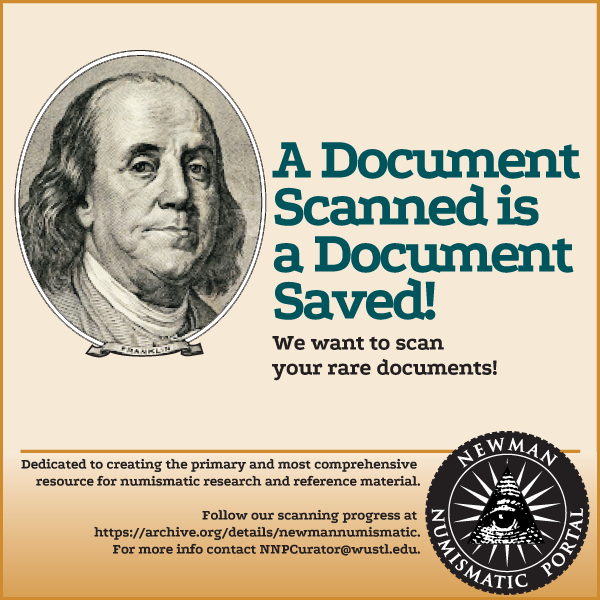
NEW BOOK: ECUADORIAN COINS - AN ANNOTATED CHECKLIST
 Ecuadorian coins – An Annotated Checklist serves collectors throughout the full spectrum. There is plenty of information for an expert or a long-time collector, enough mid-range material to get someone seriously interested in the country’s coinage and yet simple enough listings that a beginner would feel much more comfortable within it than in the Standard Catalog of World Coins. A beginner would need three volumes of the SCWC to cover the range of material displayed, even though only about 240 coins are listed, not counting the Galapagos, NCLT, NLT and special issues.
Ecuadorian coins – An Annotated Checklist serves collectors throughout the full spectrum. There is plenty of information for an expert or a long-time collector, enough mid-range material to get someone seriously interested in the country’s coinage and yet simple enough listings that a beginner would feel much more comfortable within it than in the Standard Catalog of World Coins. A beginner would need three volumes of the SCWC to cover the range of material displayed, even though only about 240 coins are listed, not counting the Galapagos, NCLT, NLT and special issues.
An advanced collector would feel challenged by the depth of the abbreviations and the titles and resources that lead one towards further study. An intermediate collector would find an easy way to track prices, grades and sources for coins offered or needed by said individual. The checklist might lead one towards acquiring a set based on KM numbers, denominations, and metallic content or even perhaps towards attempting a complete collection of known coins. The challenges of a complete set are strenuous; the number of such coins exceeds those in a World coin set of my birth year. Even a straightforward collection of one of each variety of silver coins of Ecuador is a substantial goal.
Finding a source for all of these pieces is no easy task. The listings offer some auction sale citations – but I do wish there had been Lot numbers included with the data provided. A major benefit of a well-used checklist like this could become, is that it is far more realistic in pricing and rarity than other resources available. While not a substitute for 30+ years of numismatic experience in World coins, this checklist allows one to become adept at evaluating prices and conditions available for this country’s coins and have one’s data be real-time.
Many people’s work seems to have gone into this checklist with a goal to advance research of Ecuadorian numismatics as well as Ecuadorian history. The Galapagos coins were an unexpected treat as well as a number of odd ball pre-decimal and decimal coins not listed anywhere else. Seppa combines his research with that of others to create a preeminent work covering a country he seems to love.
Overall, this is a worthy contribution to the world of coins of a small country with a 200 year history. I expect that it will lead its purchaser on a pursuit over a good many years and to many wonderful books on the subject.
ECUADORIAN COINS - An Annotated Checklist
Just released, illustrated with 124 pages including pricing information. The latest and most comprehensive listing available. Includes: pre-Colombian money, colonial coinage, coinage of the wars of independence, republican proto-coinage, pre-decimal coinage, decimal coinage, early pattern and unusual coinage, decimal patterns and unusual coinage, sets, NCLT and NLT coinage, tokens, scrip and NLT of the Galapagos and a special section on certified coins. The price is only $20.00 postpaid in the United States. Foreign orders add US$10.00 for postage.
The size of the checklist is 4 1/2 inches (115 mm.) by 8 1/2 inches (215 mm.) so that it can be conveniently carried in your back pocket or the inside pocket of a sport coat.
There is ample room for each entry to record prices and sale occurrences. The only way to know the proper price for any given coin is by recording prices of items as they are sold.
Throughout the book actual prices realized are shown to give you a head-start with your pricing records.
QUANTITY ORDERS
5 Copies $80
10 Copies $150
20 Copies $240
All U.S. Orders are postpaid and include tracking. Foreign quantity orders add $20 per order. If registry is desired add an additional $15.
Order with personal check, money order or cash (at your own risk) from: Dale Seppa, 103 N 6th Avenue, Virginia, MN 55792.
PayPal or Credit card orders can be sent through PayPal by sending the correct amount to: daleseppa@gmail.com.
NEW BOOK: MONEY
 Money, the new book edited by Tania Prill, Alberto Vieceli, and Sebastian Cremers (Edition Patrick Frey), features pictures printed on banknotes, magnified so that each line rendered is clearly visible to the eye, revealing the profound details that make each piece of currency a work of art in its own right.
Money, the new book edited by Tania Prill, Alberto Vieceli, and Sebastian Cremers (Edition Patrick Frey), features pictures printed on banknotes, magnified so that each line rendered is clearly visible to the eye, revealing the profound details that make each piece of currency a work of art in its own right.
The book features no text except a brief statement by the author at the end. As the editors write, “Money is a mystery. For the past 11 years, we have been fascinated by the visual value of banknotes, by how pictures are used—all over the world—to imprint value on paper that would be otherwise worthless.”
Money is a book about art rendered in the service of commerce, of the pictures of political subject matter, historical milestones, distinguished personages, status symbols, and landscapes. Each banknote is presented in part, rather than in whole, focusing on a specific detail and devoid of the usual context we look for when handling banknotes. Without a country of origin or a monetary value assigned to the banknote, the editors force us to look at each image purely as a form of visual iconography.
The result is a study of symbols of power and strength, and how these popular motifs inform ideas about identity and wealth. Money presents carefully cropped images of natural and manmade glory, of everything from a rhinoceros to a jumbo jet, with each image evoking an individual nation’s deeply felt sense of self. Most of the images present evoke the heroism of the past, or the quiet grandeur of the common man, woman, and child. But within this mix are modern images of a snowboarder, a computer tablet, and a satellite in space, reminding us of the ever-evolving nature of the status symbol in modern life.
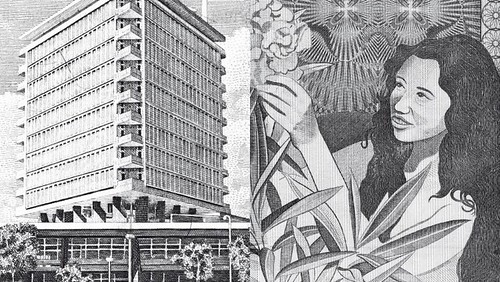
Although there are no captions or credits in the book, the currency of the United States is easily identified by its symbol of the Eye of Providence (or the all-seeing eye of God) radiating at the top of a pyramid. This image has become popular among conspiracy theorists, particularly those who believe this to be a symbol of the Illuminati, a secret society thought to be masterminding events and planting agents in the government and corporations in order to gain political power and establish a totalitarian world government.
In this way Money raises more questions than it can possible answer. What is the significance of the icons selected from each banknote, and what do they reveal about the people they represent. Devoid of context, it is impossible to know the story behind the image, and as such we must take it only as a decorative element that speaks to the human drive to symbolize meaning in order to establish value as a whole. The result is a sumptuous, albeit superficial, look at the human impulse to establish value through the formulaic creation of currency, each image as fantastical as it is familiar.
To read the complete article, see:
Books | Money – Edited by Prill, Vieceli, and Cremers
Read more at http://www.craveonline.com/art/945089-books-money#OZreI1ywKMsvT21H.99
(www.craveonline.com/art/945089-books-money)
EUR 60,00
N° 191
Editor
Design
Hardcover, 256 pages, 300 color images
For more information, or to order, see:
Our information shows Hall's birth as November 5, 1841 and death as May 14, 1909 (the latter supported in multiple numismatic places, the
former coming from several Harvard Medical school references). He was born in Boston, was educated in the area (Harvard), worked at the City Hospital of Boston and died at Chelmsford Center, MA. Dr. Thomas Hall, an accomplished Harvard (1866) educated physician, was a significant influence and collector of federal and colonial state coinages. Most known for his US large cents and Connecticut Coppers, he built important collections where collectors value his provenance, to this day.
However, his contributions to research and classification of Connecticut coppers cannot be overstated. Dr. Hall leveraged the earlier Crosby attribution system, which grouped Connecticut coppers in coarse categories by common date, legend and ornamentation. Hall devised a system of identifying each individual obverse and reverse die within Crosby's coarse groupings, and then tabulated pairings and combinations by rarity. He created an extensive hand written manuscript on his classifications, with his personal copy in the Connecticut State Library and another hand copy, believed made for contemporary William Wallace Hays, now in the Hamelberg collection (ex. John J. Ford).
These works formed the basis of Henry C. Miller's modest revisions and 1920 ANS publication on Connecticut Coppers. But, not all of Hall's work remained unpublished. In 1892, he took the 1787 dated subset of his manuscript and published it privately to solicit additions and corrections from his peers. There are up to 17 copies known today, many with some form of hand annotations by Hall to update page references or to add tidbits of information. If one assumes a low publication run and a high survival rate, it is a reasonable conclusion that no more than 20 to 25 copies of this 1892 work were printed.
One particular copy of Hall's 1892 publication has recently been located and digitized by the Newman Numismatic Portal. Hall's personal copy of this 1892 work, with extensive additions and corrections, is a fantastic addition to the two known hand written manuscripts. Based on the content of this new finding, these notes are more recent than those found in the Connecticut State Library copy of his personal manuscript, with only a subset of his new publication notes being added to that older personal manuscript. It is always a pleasure to review the personal work of early researchers and collectors of Federal and Colonial coinages, but for those who specialize in Connecticut Coppers, the work of Dr. Thomas Hall is extremely important and it is delightful to see the efforts of the Newman Numismatic Portal bringing these important findings to light.
Hall’s manuscript on Connecticut copper varieties (Ford/Hamelberg copy, one of two known):
Hall’s manuscript on Connecticut copper varieties (Connecticut State Library copy, one of two known, photocopy from Newman library):
Hall’s 1892 manuscript on Connecticut coppers of 1787 (Hamelberg copy, one of 17 known):
Burdette Johnson’s 1936 inventory of Dr. Hall’s Connecticut coppers:
Eric Newman’s die interlock chart for Connecticut coppers (1963):
Robert Friedberg Award:
The Professional Numismatists Guild is a nonprofit trade association composed of the country's top rare coin and paper money dealers who must adhere to a strict Code of Ethics in the buying and selling of numismatic merchandise. For additional information about the awards for the PNG, contact Robert Brueggeman, PNG Executive Director, 28441 Rancho California Road, Suite 106, Temecula, CA 92590. Phone: (951) 587-8300. Email: info@PNGdealers.org. Online: www.PNGdealers.org.
To read the complete press release, see:
A hoard of more than 1,300 tokens and medals from the estate of numismatist Virgil M. Brand that were originally destined for the melting pot as part of a divorce settlement has been acquired by the Chicago Coin Company.
The tokens and medals, some of which are unlisted in numismatic references, are considered to be the final vestiges of the numismatic holdings of the Chicago beer baron and prominent numismatist, who died in 1926. The tokens and medals have been stored away in the same wooden crates in which they were put into storage more than 80 years ago, according to Chicago Coin Company President William Burd.
Burd purchased in the fall of 2015 a wooden crate containing 1,230 medals and tokens and two crates containing 125 rectangular bronze USS Nashville medals still in their individual felt-lined boxes. The USS Nashville medals and their storage boxes suffered damage from their long-term storage in a moisture-laden environment, Burd said.
The 1,230 crated medals and tokens were laid out on multiple layers of tissue paper and then stacked inside one of the three crates.
Burd said he is in the process of individually cataloging each piece before deciding how to market the exonumic items to collectors.
Among the items so far identified, Burd lists these:
A 25-piece paper-wrapped roll of 50-millimeter aluminum tokens commemorating the building of the Masonic Fraternity Temple in Chicago in 1892. Written on the roll, presumably in Brand’s own handwriting, is ledger number 30801, an indication Brand purchased them in October 1905 among items totaling $84.63.
Rare shell card. Unlisted in Q. David Bowers’ reference The Token and Medal Society Guide to U.S. Shell Cards 1867-1880. The obverse design resembles that for an 1867 Seated Liberty silver half dollar, with the reverse featuring an orange insert on which is printed R.B. WHITZELL, / JOBBER AND DEALER / IN / BOOTS & SHOES, / NO. 165 / S. HIGH STREET, / COLUMBUS, OHIO.
Circa 1750 Frederick, Prince of Wales, struck medal, issued in gilt copper.
Sharply struck April 23, 1661, silver coronation medal of Charles II. Burd said the medal is one of only a few silver medals in the hoard.
Rare Winfield Scott 1852 presidential campaign medal in copper, 33 millimeters.
Bill Burd adds:
I see there is one on eBay right now, listed as one of two known. Now there's three.
Jefferson Guard medal in white metal, 40 millimeters. The medal is inscribed around on the obverse COMPANY F. JEFFERSON GUARD ★ CAPT. F. HEPPENHEIMER ★. Inscribed within an inner circle is 25TH REGIMENT ★ AUG. 11, 1859 ★. A bullseye is in the center of the obverse. A wreath is on the reverse of the unsigned medal.
Brand’s massive estate, including his numismatic holdings, were inherited by his brothers Horace and Armon upon his death in 1926.
At the time, Virgil Brand’s numismatic collection was estimated at a staggering $5 million.
The brothers spent years sorting and inventorying and attempting to split the collection equally, according to Burd.
Q. David Bowers, in his book Virgil Brand: The Man and His Era, writes that by 1934 everything in Brand’s estate was finally appraised except 16 boxes of Masonic Chapter pennies, 12 boxes of Civil War tokens, two boxes of Hard Times tokens and some items worthy only for melting.
"It seems the three crates purchased by Chicago Coin fell into the ‘melting’ category and were simply put aside for over 80 years,” Burd said. “Except for a few silver pieces, all of the medals and tokens are of base medals — white metal, copper, copper nickel, brass and aluminum."
"Being able to pedigree these items to Virgil Brand and have them return to Chicago was wonderful," Burd stated. "And now being able to supply this new material to the numismatic community is very exciting and satisfying."
To read the complete article, see:
As a follow up to the January 17, 2016 E-Sylum item, VIDEO: REDISCOVERY OF THE WALTON 1913 LIBERTY NICKEL, I thought readers might want to know some of the background about how the Walton 1913 Liberty Head nickel became a subject for a segment of the popular Fox Business Network program, Strange Inheritance.
As you may recall, I created the publicity stunt in 2003 that, Surprise! Surprise!, actually led to the re-discovery of the Walton nickel that had been off the hobby's radar for four decades. George Walton's heirs brought it to the 2003 ANA Baltimore World's Fair of Money where it subsequently was authenticated by a team led by PCGS Co-Founder David Hall in a secret midnight meeting of experts at the Baltimore Convention Center. The story of the publicity stunt and subsequent authentication are excellently described in the book, Million Dollar Nickels, by Paul Montgomery, Mark Borckardt and Ray Knight.
About three years ago I learned that Towers Productions, a Chicago-based TV production company, was launching the show Strange Inheritance and producers were looking for subject material. As a former Windy City broadcaster (25 years with CBS/Chicago -- with scars to prove it), I was familiar with this first-class production company, and thought the Walton nickel saga would be a perfect fit for the planned show.
I contacted the producers and helped them get in touch with Walton's heirs, Montgomery, Hall and Heritage Auctions which had sold the coin several months earlier at the 2013 Central States Numismatic Society convention. Unfortunately, I had a conflict of schedule and was unable to be available for a requested on-camera interview during the production of the segment. However, I provided some of the photographs I shot in Baltimore in 2003 that are shown in the second half of the TV segment. (The link in the January 17, 2016 E-Sylum was for the first part of the segment.)
Every time I think about the Walton nickel (and another story in which I assisted Strange Inheritance producers, the "Black Swamp Find" of $2+ million dollars of century-old baseball cards found in an Ohio attic), I wonder: "What other great discoveries are yet to be made in coins and other collectibles? And will I get to help with the publicity?"
With an armed security guard outside, happy participants posed for a photo after the initial examination of the Walton 1913 Liberty nickel in the cramped Show Manager's office at the Baltimore Convention Center in July 2003. From left to right: Gary Myers, Paul Montgomery, Cheryl Myers (one of George Walton's nieces), Ryan Givens (one of Walton's nephews), John "JD" Dannreuther and Mark Borckardt. Cheryl and Mark are jointly holding the nickel that's inside the custom-made holder in which the nickel was housed when it was recovered from the 1962 car crash that killed Walton on his way to a North Carolina coin show. Photo by Donn Pearlman.
Exhausted but elated, the Professional Coin Grading Service team that authenticated the Walton 1913 Liberty nickel in a secret midnight meeting pose with all five 1913 Liberty nickels on the table in front of them in Baltimore, Maryland at about 12:45 am on July 29, 2003. Front row left to right: John "JD" Dannreuther, Paul Montgomery and Mark Borckardt. Top row left to right: David Hall, Fred Weinberg and Jeff Garrett. Photo by Donn Pearlman.
To read the earlier E-Sylum article, see:
Query: Famous Farmer Numismatists
Pete Smith writes:
This morning I was writing the biography of a coin collector who had been a farmer. It occurred to me that I could not think of another farmer who was a coin collector. Can any E-Sylum reader identify a farmer who had a collection good enough to be mentioned in numismatic literature?
Query: Dickeson Copy of Sommers Island Shilling?
David Pickup writes:
Here are photos of a copy Hogge money shilling I bought recently for £2.50. Looking at the internet I am wondering if it is a Dickeson copy. Any thoughts?
Bribing Politicians Overstamp on U.S. $1 Note
Got this dollar bill with graffiti (graffitus?) not seen before: NOT TO BE USED / FOR BRIBING / POLITICIANS / AMEND THE CONSTITUTION. Now what self-respecting politician would take a one dollar bribe?
Roger Burdette Wins Mallis Award
On Melting Ancient Coins in India
Ken Berger writes:
In the last E-Sylum you wrote, "I've heard all about the stealing and smuggling of ancient coin finds. But melting? This item from The Times of India discusses a proposed law to prohibit the melting of ancient coins. Really? Is it possible for them to be worth more simply as bullion?"
No, they are obviously not worth more as bullion but the melting does not surprise me.
India has 37% of all the illiterate adults in the world. This equates to 287 million illiterate Indian adults (which is the largest population globally), according to a report by U.N. Educational, Scientific and Cultural Organization (UNESCO).
Thus, an illiterate individual who has an old coin knows it has no current monetary value and therefore cannot be spent. However, he also knows that the coin is made of gold or silver (and quite possibly alloyed with another metal) which does have a value. So, the obvious decision is to melt the coin, separate the gold or silver, and sell it. Also, it is highly unlikely that even if the individual knew of the coin's collector value that he would have access to the market where it could be sold.
So, you should not be surprised by the melting of old rare coins solely for their bullion value.
Ken adds:
Also, gold is very important in Indian culture. At the time of marriage a dowry (preferably gold) must be given. Many poorer families spend literally every last cent they have on the dowry. Without a dowry, the daughter will have an extremely difficult (if not impossible) time trying to get married. (This is one reason why sons are preferred over daughters. Also, why female infanticide is practiced). The gold is made into jewelry. Gold jewelry is very common in India.
To read the earlier E-Sylum article, see:
The Shifting Bowie Persona Anti-Counterfeiting Device
Last week I wrote:
When I read that they wanted to put Bowie's face on a banknote I immediately asked myself, "Which One?" Which face that, is - as the article notes, celebrity Bowie was a chameleon, changing looks and personas on a regular basis.
Chip Howell writes:
Here's a great opportunity for a new anti-counterfeiting measure: his face could morph from the Thin White Duke, to Ziggy Stardust when you change the viewing angle. Let's see ne'er-do-wells fake THAT!
To read the earlier E-Sylum article, see:
Countermarked 1756 French Ecu du Bearn Info Sought
Robert Laviana writes:
The attached coin represents a Kingdom of France 1756 Ecu du Bearn (Pau) with an undetermined countermark. It may be a 'C' for Cayenne, a 'G' for Guadeloupe, or something else. Any suggestions or insights from E-Sylum readers would be appreciated.
I have written extensively about collecting plaster models in previous issues of The E-Sylum. But let's first inform ANA's correspondent what medal they have. It was issued by Presidential Art Medals as part of their Space Series. It was indeed by Adlai Hardin (1901-1989) a seasoned sculptor who replaced President's long-time sculptor Ralph Menconi for this one medal. It was struck by Medallic Art Company and is their catalog number 1973-158.
Plaster models are what a sculptor creates from his original model, usually in clay or plastiline. The plaster model is brought to the medallic company which uses it to make a metal shell by the electrogalvanic process. The plaster cannot be used to cut a die, but the metal shell can serve as the pattern to do this. The. metal pattern is oversize, the same as the plaster model. From this dies can be cut any size.
Granted a plaster model is last touched by the hand of the original sculptor, but it is only a means of transporting and providing the required image to the medallic company. It is not permanent, it breaks or chips easily and must be handled very carefully.
Sculptors occasionally cast two of these in plaster, the second they keep in case the first is damaged in transit, an inexpensivve insurance policy. I once directed a team to photograph and place over 600 plasters on specially built racks for the estate of a sculptor.. My team did not break a single one (although we cataloged several that were!). This was reported in E-Sylum April 6, 2008 (vol 11, no 14, art 6)..
I have said in the past plasters are not for beginning collectors. They need to be handled and stored carefully. Thus I don't recommend inexperienced collectors to obtain these. I have observed too many damaged by unknowing individuals. Conversely for seasoned numismatists I have recommended they obtain one plaster and one die to familiarize themselves with the technology of making a coin or medal. For this I have outlined five points in handling and care of plasters, (E-Sylum/ Nov 15, 2015, vol 18 no 46, art 18)
What can be done with a plaster? I recommend framing it behind glass in a shadow box with an attractive color background cloth. Makes an ideal decoration of numismatic interest hanging on your wall.
The most often asked question: what are they worth? Perhaps not what you might expect. A plaster of an important medal might bring over $100, Most far less. It is worth what you consider the cost for an attractive wall piece.
To read the earlier E-Sylum articles, see:
James "Norman" Shultz (1893-1988) 725 East Platte Avenue, Colorado Springs, Colorado; King City, Missouri; Salt Lake City, Utah. He was born on April 2, 1893, son of Henry Otis Shultz (1869-1920) and Lulu Alice Vaughn (1872-1896). In 1900 he lived with his parents in Jackson, Missouri. In 1910 he lived in DeKalb, Missouri. In 1915 he began coin dealing at age 22. In 1920 he returned to Jackson, Missouri. He married Mattie Cook (1899-) sometime before 1922 and moved to Colorado Springs, Colorado. In 1930 he moved to Salt Lake City, Utah. He married his second wife was Elsie Laura Sterzer (1913-2011) at Eddy, New Mexico in 1940. The couple returned to Salt Lake City, Utah, where they remained until his death. He died on June 18, 1988 at Salt Lake City, Utah.
Coin and stamp dealer, published catalogs and advertised in Hobbies Magazine in 1918 and in 1936 in Numismatic Scrapbook. Due to the popular confusion of this surname with the German spelling oftentimes his name was spelled Schultz in advertisements and in his publications.
Mr. Shultz helped organize the Salt Lake Camera Club and the Coin Club of Utah. Owner of Norm Shultz Numismatics, he was in the coin business for 65 years and was one of the oldest coin collectors in the country.
In 2001 Shultz was inducted into the ANA Hall of Fame.
To read the complete article, see:
Can the E-Sylum readership make high confidence predictions about the future of coin collecting? How might a coin dealer, specialist, general collector, investor, or accumulator best survive if not thrive? This might be a good thought experiment for the readership.
I think we ought to look ahead at future anniversaries such as the 250th of the American Revolution in 2025 and publish a “future timeline” of events for coin collectors, to gauge likely events and popular interest in the years ahead, as they may plan to sell their collections using a countdown to the target year. They say coins tied to great historic events are worth the most the year before a major anniversary happens. Think of the surge in interest in Titanic items in 2012, or 1715 Fleet coins and the recent 2015 auction by Dan Sedgewick. What’s next? Who will fall from favor like Columbus, popular at his 400th and ignored at his 500th anniversary? Would a readership poll of interest in historic events by Boomers, Gen-Xers and millennials help? Also see predictions of dwindling natural resources including certain precious metals if industry continues at pace.
Nostalgia follows in a somewhat predictable manner, about twenty-five years after, when those who lived the event as children have money and leisure to pursue all those things they wanted, but were denied in youth. Also consider future problems such as new and pending understandings with foreign governments who claim ownership of all historic coins, and which now require collectors of certain ancients to document their collections to prove they were not exported recently in violation of treaty, or from restricted sources. Third-party graders do not slab ancients very well, but what is needed is recent provenance on paper.
This 140-year-old landmark had
the dubious honor last week of
being named by the National
Trust for Historic Preservation
as one of America’s 11 most endangered
historic places, and no
wonder: ascend the steep steps
and what strikes you is not the
splendor but the stench.
City
Hall awarded the building in
2003 to a well-intentioned historical
society, then paid little
attention while plans for a museum
foundered. Now the sandstone
walls stand empty while
the granite porch atop the grand stairs from Mission Street doubles
as a homeless camp. The
landscape is dying as the ornate
fence succumbs to rust. Amid
all our pressing civic issues, the
fate of a tattered icon may not
seem important—but neglect at
this scale should embarrass the
leaders of a prosperous city that
claims to value its past.
The San Francisco Old Mint
was a coining facility from 1874
until 1937, and after it closed it
was converted into office space for
several federal agencies. In 1972,
under the direct involvement
of former Mint Director Mary
Brooks, the Old Mint was restored
to most of its original splendor,
both interior and exterior, and
eventually became a museum,
opening to the public in 1974. Inside
were displays of coining and
mining artifacts; numismatic collections;
and antique furniture
(once used in the mint). A gift
shop and regular guided tours of
the basement and first floor also
drew visitors.
However, in 1994 the museum (as well as the entire structure)
closed due to operational costs
and the need to seismically retrofit
the entire building. (The latter was
necessary be-cause of modern
seismic codes, even though the
mint was built so strong that it survived
the 1906 earthquake with
little damage and remained virtually
intact (although the building
moved two feet to the south).
Following the closure and removal
of almost all the exhibits,
the property was transferred from
the U.S. Treasury Department to
the General Services Administration
(GSA), which is technically
the federal government’s “landlord
agency.” The GSA never developed
a renovation plan, and the
building languished until June
2003, when the agency decided to
transfer the property to the City
and County of San Francisco for a
ceremonial charge of $1.
A genuine sense of hope became
evident when the nonprofit San
Francisco Museum and Historical
Society (SFMHS) stepped forward
and offered to lease the facility.
A contract was negotiated, and the
work of fund-raising began in
earnest. After some initial success,
the society removed the debris accumulated
over the years, effected
major repairs, and made the interior quite presentable for public
events, spending $14 million in the
process over an 11-year period.
However, the society’s dream
of a grand museum for San Francisco,
at an estimated cost of
around $60 million, began to diminish,
as did the donations to
make it so. Why the downturn of
contributions in the society’s later
years? It could have been the sluggishness
of the national economy
around 2008, and the fact that
history museums are not as popular
with wealthy benefactors as art
or ethnic museums. Despite an almost
monthly promotion of various
events at the Old Mint to raise
funds, the amount coming in was
not nearly enough for the SFMHS
to aggressively pursue its plans.
At the end of the first quarter of
2015, the City of San Francisco ran
out of patience with the SFMHS,
terminated the organization’s lease,
and decided to move in another
direction. A city representative reported
“a lack of progress, which
forced us to pursue alternative
means.” This same official, however,
did praise the SFMHS for its
work, and added that the society
gave “a glimpse of what this treasure
can and should become.” (To
view 50 excellent photos of the
mint, see photographer Ron Henggeler’s images taken just before
the SFMHS vacated the building
on August 1, 2015, at
www.ronhenggeler.com/Newsletters/2015/8.8/Newsletter.html
).
Another city newspaper reporter
recently noted in his regular
column that the average San Franciscan
seems to accept the beggars
and street people who camp out
on the granite steps and around
the mint, and the odor of urine
that lingers. He added that maybe
the people have lost pride in their
city and have decided to shrug and
accept the idea that anything
goes. He cannot imagine any historic
building in England being
treated this way.
Why is it that New Orleans and
Carson City maintain the integrity
of their old federal mints, with
public museums attached, while
San Francisco does not? As the
above-noted reporter suggested,
the answer seems to lie in public
apathy. Such a sad state of affairs!
So, what is to be done with this
historic building that once played
a major role in the nation’s financial
affairs and was the largest
contributor to San Francisco’s recovery
after the earthquake and
fire of 1906? And what about its
numismatic history?
San Francisco Chronicle
reporter Bob Bragman reported
on December 19:
The Old Mint, a San Francisco
landmark, has sat in a state of
shameful disrepair for too many
years. But maybe that’s about to
come to an end. I sit at a desk in
the old Chronicle building, lucky
enough to have a view that overlooks
the grand monument,
which itself is a testament to San
Francisco’s tenaciousness.
His article (which can be read online
at www.sfgate.com) has given us
renewed hope for the structure.
Bragman stated that for several
weeks he has observed workers doing
some major cleanup on the mint
grounds.
Two workers emerged
from the building, and when Bragman
inquired as to what was going
on, he was told that the city government
had appropriated funds
to “repair the place inside and
out” and provide 24-hour surveillance
at the site. They also added
that the extensive graffiti on the
walls would be removed in a way
that would not harm the stone.
Bragman added that San Francisco
Mayor Ed Lee said in a press
release, “We are taking the first
step to fully renovate this landmark
so that the community can
enjoy it for generations to come.”
We are surprised and quite
pleased by this news, and hope
this restoration will bring back the
respect the Old Mint of San Francisco
deserves.
To read the complete articles, see:
To read the earlier E-Sylum article, see:
British coins and tokens, along with unusual Americana and choice Roman Imperial in Davissons Ltd February 3, 2016 auction
The February 3, 2016 closing date sale from Davissons has 423 lots of coins, tokens, and medals, mostly of British interest. (There is no buyer’s fee in Davissons Ltd sales.)
One of the most comprehensive offerings of British coins Davissons has offered in over 40 years, including Scottish rarities, anchors their Auction 35. Every reign from the Norman Conquest on is well represented, going beyond single examples to include many varieties.
Anglo-Saxon is well represented, with coins ranging from an affordable Edward the Martyr up to many exceptional pieces such as Coenwulf, Æthelstan, Harold I, and Harthacnut, many with well-established pedigrees.
The Viking section includes the very rare St. Peter sword type penny with central cross.
Hammered gold opens the sale, but the real strength is in high-quality silver, including an exceptional and very rare Edward IV/V groat from the 1913 Walters sale, lot 167. The collection was based almost entirely on American sources beginning in the 1960s. The consignor commented, half-kiddingly, that he bought coins from whoever would send him catalogs, so large firms such as Coin Galleries are more represented. Davissons also provided him with some better material during the early years of their business.
One of the most fascinating pieces in the sale is the Henry and Mary ryal of 1566, lot 291 [image included]. Allan Davisson has only been able to trace three examples in his 40 years in business – one in the Lockett collection, one in the National Museum of Scotland, and this piece.
Henry Darnley, a cousin of both Elizabeth I and Mary, became Mary’s husband in 1565. A dashing but dissolute spouse, Henry began scheming early on to become the real rather than the titular king on the Scottish throne. In these intrigue driven times, there was little problem finding influential backers. Protestant nobles like the Earl of Morton and Sir William Maitland brought a plan to gain the throne for Darnley.
Their effort to traumatize Mary by murdering her confidante and secretary, David Riccio, in front of her failed. Mary, pregnant at the time with the future James VI/I rallied an army and routed the plotters. Maitland may have been defeated but was apparently not daunted. An article on Marian coinage (BNJ 1987. Joan Murray, “The Coinage of the Marians in 1572”) cites him as involved in the 1572 counterfeiting of half merks and quarter merks during the reign of James.
Darnley was assassinated in 1567 in a plot that became a significant factor in Mary’s downfall.
This article and a subsequent article in the 1989 BNJ (Rampling and Murray, “An Addendum…”) notes that the piece “has none of the properties of the ryal now provisionally attributed to a Marian source.”
While neither of the BNJ articles suggests it, it does seem a reasonable assumption that this coin issued with Henry’s name first, HENRIC & MARIA, was issued by the pro-Henry plotters. An issue date of 1566 using a genuine 1566 reverse die matched with a “custom made Henry primary” die does not require much of a speculative stretch. Interestingly enough, the weight, particularly of the piece in this sale, was within the tolerance range for a regular issue. The genuine die does not show the rust or deterioration that might be expected from a die that sat around for several years before its use.
The piece itself is very rare. I have been able to trace only three examples: the Lockett example (Oct 1930:913.) (Lockett also had a two-thirds ryal with the same reading, lot 911.); the SCBI National Museum of Scotland example, 1189; and this piece.
Other important numismatic areas are also broadly covered. A group of exceptionally high grade Roman silver and bronze coins precede the British section. While there are rare pieces such as a good VF example of Gordian I, there are also exceptionally fine coins of other reigns such as Claudius, Galba, and the usurpers Laelianus and Constantine III.
An extensive listing of British trade tokens includes several lots that have not been on the market for at least 50 years.
An unusual and historic group of Americana – mining ingots, 19th century silver and copper presidential medals, even a set of dies for a medal – conclude the sale.
Estimates are at the conservative end of the market. Grading is conservative as well. A few bids from specialists finding unusual pieces have already come in.
Davissons have been in business for over 40 years. A high quality print catalog is available at no charge on request. They can be reached by phone at (320) 685-3835, email at info@davcoin.com, or mail at PO Box 323, Cold Spring MN 56320 USA. The whole sale is available to view and bids can be placed online at
www.davcoin.com
.
Jeff adds:
It’s a neat coin, and proof that rarity and story don’t always come with six-figure price tags.
To read the complete article, see:
To read the earlier E-Sylum article, see:
For collectors of Holy Land coins without deep pockets, there are about 40 lots of Judaea City Coinage issued by the Romans in Akko Ptolemais, Caesarea Panias, Gadara, Caesarea Maritima, Sepphoris, Tiberias, etc. generally priced in low 3-figures.
Online bidding for the sale will be on GoldbergLive Auctions at goldbergcoins.com, where the catalog can be viewed.
To read the catalog, see:
To read the complete catalog, see:
Lot 3003: 1794 Liberty Cap Half Cent. Cohen-4a.
Published in Penny-Wise beginning in January 1974 and continuing until September 1977, Milton Pfeffer’s remarkably thorough survey of appearances of half cents covered nearly 2,500 auction catalogs found in the library of the American Numismatic Society. He identified just three appearances of specimens of this variety that had been described as Uncirculated in sales earlier than the private sale of the Howard Newcomb half cent collection to Col. E.H.R. Green. One of them was in the legendary June 1924 Alvord sale as lot 22, described as “Uncirculated. Splendid impression with beautiful light brown color. Very rare state.”
Sadly, the coin was not among those depicted on the five photographic plates, but it was evidently quite beautiful: lot 22 brought $38.50, more than the prices of the first three 1793s combined and more than the 1796 With Pole. The piece in Thomas Elder’s April 1925 sale (lot 2148) was described similarly, “Uncirculated, light brown. A gem, seldom equalled.” Pfeffer’s other reference is to an April 1923 Elder catalog, but no such sale exists; we have not tracked down the sale he intended. It is possible, given the timing and the language, that all of these references are to the same coin.
Without the benefit of photographic plates (or first-person documentation), it will be impossible to prove that this coin is the Alvord specimen, but that seems likely. Newcomb acquired at least one other Alvord coin, a Mint State 1793 C-1 that Newcomb purchased from Henry Chapman after the sale.
To read the complete lot description, see:
Lot 3015: 1793 Flowing Hair Cent. Sheldon-9
Even though the Sheldon-9 is lodged in the middle of Crosby and Sheldon’s descriptive sequence, modern research suggests this is one of two varieties with a claim to have been the first Wreath cent struck. The obverses and reverses of the 1793 cents were impeccably described by Crosby in 1897, well enough that Sheldon commented in Penny Whimsy that “Crosby’s book was so accurate and complete that in the half century since its publication no further varieties of 1793 have been found.”
Ironically, it took until the age of encapsulation for researchers to pay proper attention to edges. In a paper that arose from the study of the Strawberry Leaf cents, Jim Neiswinter published observations made in concert with Dan Holmes, Bob Grellman, and then-current and former ANS curators Robert Hoge and John Kleeberg regarding the edge dies of 1793 cents. His article appeared in the March 2005 issue of Penny-Wise, following comparison of the two Strawberry Leaf cents owned by Dan Holmes to the Parmelee specimen, when on consignment to American Numismatic Rarities in 2004, and the specimen owned by the ANS. Neiswinter et al discovered that all Wreath cents except for Sheldon-8 and Sheldon-9 shared the same edge die. The Strawberry Leaf cents likewise shared this device. The Sheldon-8 and Sheldon-9 edge device was produced from the same edge die that milled the edges of all Chain cents that were studied, including Sheldon-1 through Sheldon-4 and 1793 NC-1.
This edge evidence confirms that the planchets used to strike Sheldon-8 and Sheldon-9 were milled before the planchets used for the other Wreath cents, prior to the edge dies being changed in the Castaing machine (also known as an edge mill). While the first planchets prepared do not necessarily need to have been the first planchets struck, the evidence Bill Eckberg published in Penny-Wise in September 2010 is persuasive. The coiner’s account book consulted by Eckberg, discovered in the National Archives by Craig Sholley, shows that while Wreath cent planchets were being milled from April 3 to April 6, Wreath cent coining began on April 4, confirming that the final Wreath cent planchets to be milled were among the last to be struck. Eckberg posits that the milling process had begun a few days before April 3, but the surviving documentation begins on that date; the earlier account book has not been found.
Eckberg’s 2010 study also delved into emission sequences and die states. Sheldon-8 and Sheldon-9 share an obverse die, but the die state of that obverse is always later on Sheldon-8 than on Sheldon-9. This obverse, Crosby’s Obverse 9, was also used on 1793 NC-4, but all four survivors of that variety are too low grade to determine their die state. Gathering the die state evidence and the edge die evidence, the data strongly suggests that either NC-4 or Sheldon-9 was the first Wreath cent struck.
To read the complete lot description, see:
Lot 3132: 1807 Capped Bust Left Half Eagle
The beginning of the Capped Bust design type in 1807 heralds the appointment of engraver John Reich to a permanent position the United States Mint. Reich first arrived in Philadelphia from Germany in 1800. A year later, he performed his first work for the Mint, executing the dies of the 1801 Thomas Jefferson inaugural medal that also served to commemorate the 25th anniversary of the Declaration of Independence. After several years assisting with medals by contract, Reich was finally hired as a full time engraver at the Mint on April 1, 1807. He began working immediately. On April 3, Mint Director Robert Patterson wrote to Thomas Jefferson that “Mr. Reich is now preparing a set of new dies, in which some improvements in the devices will be introduced (adhering, however, strictly to the letter of the law) which it is hoped will meet with public approbation.”
The dies, undoubtedly master dies of this new design, could have been those for half dollars or half eagles. Mint Director James Ross Snowden wrote in 1860, “if our conclusions be correct, the first issue of coins of the new type took place on the 30th of September, and consisted of 15,967 half eagles.” He added in a footnote that “there was no gold of any kind coined at the Mint after the middle of June, until this time,” referring to the late September delivery of half eagles. Just two varieties of Capped Bust half eagles were coined before the end of 1807, struck from the same obverse die and two different reverse dies. The first reverse die developed a crack and was replaced by this one, which was also used for the first two die marriages of 1808. Snowden’s math has turned out to be inaccurate in retrospect, and modern authorities agree on a total mintage figure of 51,605 1807 half eagles of this type. Most of them were from this die marriage.
To read the complete lot description, see:
Stack’s Bowers gave CoinWeek readers an exclusive private lot viewing of some of the the rarest and most important coins from the upcoming third sale of the coins of the D. Brent Pogue Family Rare Coin Cabinet. The Pogue Collection is the most valuable collection of U.S. coins ever assembled, and quite possibly the most important collection of coins assembled in the past 50 years.
On February 9, 2016, Stack’s Bowers and Sotheby’s will team up once again to offer collectors the unprecedented opportunity to acquire more than a hundred of the finest known surviving examples of United States half cents, large cents, dimes, half dollars, three dollar, and five dollar gold.
To view the complete video, see:
The set of Crowns – three in gold and three in silver – passed from Sir George to his long-time secretary and personal assistant, Fairlie Hopkin, and are being auctioned following her death aged 99 in April 2015. Housed in a contemporary maroon fitted leather case, gilt blocked ‘Edward VIII King and Emperor 1936’, they have never
been on the market before and are expected to fetch £3,000 to £5,000.
Hearn, a London coin dealer, decided to strike the set of fantasy coins
commemorating the short reign of Edward in 1954. Before he embarked on this project, he doubtless had to seek permission from Edward, who became Duke of Windsor following his decision to relinquish the throne and marry the American divorcee, Wallis Simpson. The way to obtain this was to approach Sir George, who had continued to be Edward’s private solicitor and confidant.
Approval was given and Hearn had the presentation cases specially made for a handful of people. It is believed that only two or three were produced to be given to the former monarch’s closest advisers. Sir George, who Edward once described as having “stood like a stone wall during our worst hours” was an obvious candidate toreceive this extremely rare gift. It is possible that the set was given by Hearn to
Edward who then passed it on to Sir George.
Although the Hearn coins designed by George Alfred Holman were later minted in greater numbers, the ones to be auctioned at Dix Noonan Webb are rare, not only because of the presentation case, but also because they are of the original type with thick flans struck by the medallists John Pinches. No more than 100 of each of the
three gold coins in the set were produced in this first striking. Later restrikes made in the 1960s to satisfy demand from coin collectors have thinner flans.
“The provenance of this set is impeccable, leading directly back to Sir George who was at the heart of the abdication crisis,” says Peter Preston-Morley, coins expert at Dix Noonan Webb. “It was Sir George who persuaded Edward to address the nation directly, helped with the drafting of the abdication speech and advised on the terms of
Parliamentary legislation. He and his loyal secretary Miss Hopkin found themselves playing a discreet but crucial role in a drama that gripped the world.”
Dix Noonan Webb will also be auctioning a unique archive of photographs, books and films about Edward and Mrs Simpson collected by Miss Hopkin. This includes a copy of the first official photograph of the couple together, signed by both of them, and a telegram from them to Miss Hopkin expressing condolences
For more information about Dix Noonan Webb, see:
I was traveling again this week, this time heading to St. Louis on Monday for meetings with the Newman Numismatic Portal project. After a nice lunch at the airport I took a taxi to my hotel, the Knight Center on the campus of Washington University in St. Louis. Len Augsburger was already there, and I visited his room to review some new books for the scanning queue.
Len had stopped at Dan Hamelberg's house in Champaign, IL and picked up some more great auction catalogs - this time a batch of Thomas Elder sales. I showed Len some items I'm lending from my own library, including writings of Glenn A. Mooney on happenings at the Carnegie Museum of Pittsburgh Section of Coins, and multiple runs of publications named Numisma.
QUICK QUIZ: How many different publications in the U.S. have had the name Numisma? How many elsewhere?
Later that evening Len and I met up with John Feigenbaum and his developer Greg Bradley for dinner. We first had a drink in the 4th floor lounge at the Knight Center, then Len drove us to a nearby Mexican Restaurant. We discussed the Newman portal of course, but also other of their web site projects, computing history, great restaurants, and Presidential politics.
I got up early for breakfast and was the only one at the buffet when Gary joined me, soon followed by John. While they worked together I went back to my room to work on The E-Sylum a bit. A little before 9am the four of us gathered in the lobby and headed to the Olin Library for our meetings.
A number of meetings were planned. We spoke with WUSTL technology folks about the servers being set up for NNP, and the Archive-IT functionality from Internet Archive that we're exploring for backing up important numismatic web sites. The main event was Len's presentation on progress for our first year and plans going forward.
Eric Newman's son Andy represented the Eric P. Newman Numismatic Education Society, and Chris Freeland led the staff from Olin library.
After our meetings concluded Len drove us to the West Campus to visit the new NNP scanning room.
I was pleased to see that student Emma Gwaltney was in the middle of scanning my set of the Pennsylvania Association of Numismatists' The Clarion for the portal. Here are a few more photos.
It turned out John Feigenbaum and I were on the same United flight to Dulles airport; he was getting a connection to Virginia Beach - I got off and headed home, since I live just 15 minutes away in the western suburbs of Washington, D.C.
I'd been watching news of an approaching storm and the forecast kept getting worse. I worked half a day and my office closed at noon along with the entire Federal government. I saw my first snowflake on the drive home. It snowed until midnight Friday, often at blizzard force. We hunkered down at home and luckily the power stayed on. When it was all over the storm had dumped 3 feet of snow on our area. Not inches, feet - a total of 36 inches. Here's a view of our sidewalk from about 9am this morning.
I had drawn up a lengthy to-do list for the weekend, but I ended up having time only for The E-Sylum. Between entertaining my younger two, shoveling a space for our dog and taking him out throughout the blizzard, I also shoveled out our driveway, cleaned off my car, and cleaned snow off our brand-new deck out back. Our two strapping teenage boys were a big help; I'm stiff and sore now, and can only imagine how I'd feel if I'd done it all alone. Whew.
Many thanks to the E-Sylum readers from all over who inquired about our situation. We were fine, and especially lucky to have a nice neighbor with an industrial-strength snowblower. He cleared a roadway throughout our cul-de-sac, and we can all drive out if needed. But the whole region will still be digging out for a while.
Ron Ward writes:
Mathew Wittmann should be congratulated for his excellent article, “Lottery Mania in Colonial America”. I was
glad to see it reprinted in The E-Sylum. Unfortunately, there is no modern publication covering the colonial period.
There is one further publication of interest: “Colonial Lotteries in America” by Georgette Heeney, 69 pp., (1910)
[Reprint from the collections of the University of California Libraries]. This was a Master of Letters Thesis
submitted by Ms. Heeney to the Berkeley Faculty of the University of California.
It gives a brief history of British lotteries and then goes into the American Colonial lotteries giving details such as the
preparation of various tickets and the differentiation of official and private lotteries. Unfortunately, there are
no illustrations. I purchased a copy from Amazon.com.
To read the complete article, see:
Dave Schenkman writes:
As a follow-up to the item on John L. Sullivan, attached are pics of a token depicting him. In my article, “Numismatic Mementos of Professional Boxing,” which was published in the June 2015 issue of The Numismatist, I commented that:
"A rather plain 29mm aluminum medalet was produced depicting Corbett’s bust on one side with NEW ORLEANS SEPT. 7, 1892, and JAS. J. CORBETT below. The other side is similar, but with a bust of Sullivan and his name. The piece is holed at the top, suggesting that it was worn as a souvenir of the contest. It is listed as number 362 by Eglit who notes that during the Columbian Exposition both men were popular sideshow attractions."
It is well recorded in literature that
the sport of boxing (or the bare-fisted version
called “pugilism”) was known in ancient
times. In his standard reference Greek Coins
and Their Values, David R. Sear lists a silver
stater (#5394), struck c. 385-370 B.C., that
he describes as picturing “two naked
athletes [standing] face to face,
their hands raised in the attitude
of boxers.”
With the fall of the Roman
Empire, boxing declined in
popularity, and it wasn’t until
the early 18th century that it
began to evolve into the sport
we know today. In the 1700s,
pugilism was popular among England’s working class, but was little
recognized in the rest of the world
until the beginning of the 19th century.
Pugilist Thomas Johnson became
champion of England about 1787. His most famous
fight took place near Banbury two years
later, on October 22, 1789. The brutal 62-round
battle, in which he defeated Isaac Perrins, was
marked by the issuance of a 34mm copper token.
The obverse features a bust of Johnson, while the
reverse bears the legend SCIENCE AND INTREPIDITY and date 1789 surrounding BELLA!/HORRIDA/
BELLA! (“Wars! Horrid Wars!” a quote from
Virgil’s Aeneid). A companion piece carrying a
bust of Isaac Perrins also was struck. Its reverse
design is similar to that of the Johnson token, but
with the words STRENGTH AND MAGNANIMITY
along the perimeter.
England’s boxing champion in 1792-95 was
Daniel Mendoza, who is credited with developing
a
new style of fighting that incorporated defensive
moves. Mendoza was 5´7˝ tall and weighed only
160 pounds, but his innovative approach enabled
him to prevail over larger and stronger opponents.
He was so popular in Great Britain that admission
was charged for his third fight, the first time
onlookers paid money to watch.
Mendoza was immortalized numismatically on
a variety of tokens struck in the 1790s. An obverse
die featuring his left-facing profile was combined
with several reverse dies, undoubtedly to create
rare types for collectors of the period. Thomas
Spence, a London merchant (and one of the most
famous revolutionaries of his time) who described
himself as a “bookseller, dealer in prints & coins”
on his own advertising tokens, was responsible for
these concoctions, which were struck in copper on
29mm planchets.
For more information about the American Numismatic Association, see:
To read the earlier E-Sylum article, see:
The rare 22-carat coin, issued in 1966 to mark the 50th anniversary of the rebellion, was brought to Belfast Auctions in Duncrue Industrial Estate by a married couple who believed the commemorative piece was made of brass.
On Monday night the piece was sold to a private collector for a total of £3,580, including fees.
Paul Millar, owner of Belfast Auctions, said: “The piece generated a fair bit of interest. Given that this year is the centenary celebrations, it’s a poignant time to be selling. However, its gold value alone always meant that interest would be high.”
It is estimated that the gold value alone of the coin is over £2,500. In 1966 when the coin was made gold was valued at around £34 an ounce, but today it’s £750 an ounce.
“The couple who brought the piece in to us actually had two identical coins that had been bought in 1966 and passed through the family. I believe they had been lingering in a drawer of their house and they thought that the centenary celebrations would be an ideal time to valuate them,” added Paul. “They believe they were brass but having seen similar pieces I knew it was solid gold. The couple opted to keep one of the coins but we are delighted that we were able to accommodate two happy parties.”
To read the complete article, see:
Coin experts cannot be sure how the two inch long nail ended up in the US Mint production line but said it was one of the most unique and mysterious errors ever made.
Some of American president Franklin D Roosevelt's face can clearly be seen on one side, as well as the words 'In God We Trust', with a flaming torch on the other side.
No date has been stamped on the nail and nothing is known about when or how the odd item was made.
But it is believed the coin was struck in about 2000 or possibly a few years earlier as it appeared in the coin collecting community shortly after this.
Some people have suggested it was made on purpose by a rogue Mint employee.
The US Mint have made errors in the past and it is believed there are about six examples of coins struck onto nails - another dime nail and four Lincoln penny nails.
To read the complete article, see:
ROBERT Burns will take pride of place on the front of Scotland’s first plastic £10 note
The poet – whose 257th birthday will be celebrated around the world on Monday – retains his place when the Clydesdale Bank’s new polymer notes go into production later this year.
Like the bank’s current £10 notes, the new design – revealed yesterday – has views over Edinburgh on the reverse side.
The bank launched the UK’s first polymer £5 note in March last year.
After signing the new note, Clydesdale Bank chief executive officer David Duffy said: “It’s a very exciting time for Clydesdale Bank. Signing the new £10 note featuring Robert Burns underpins our commitment to building a strong, stand-alone bank based here in Scotland that can provide a real challenge to the big UK banks.
“It’s a privilege to see my signature alongside his portrait.”
Clydesdale Bank issues the largest volume of banknotes in Scotland, introducing around £400million worth every year.
To read the complete article, see:
In HCM City, money changers are offering newly minted notes of VND500 (2 US cents) to VND10,000 ($0.45) for a fee that is between 9 and 16 per cent of the value of the note.
"Most customers want only VND500 and VND1,000 ($0.05) notes. The fee is 16 per cent and notes of VND10,000 are around 6 per cent," an owner of currency shop in Phu Nhuan District said.
Most people prefer new and smaller banknotes for donations to pagodas. For use as lucky money for Tet, they buy notes of VND10,000 and more.
"My money exchange service often reaches VND600 million ($27,000) in sales one month before Tet. I can earn around VND100 million ($4,500) profit," he said.
Currency shops in wholesale markets, such as Ben Thanh Market and Tan Dinh Market, are offering "money trees" of different sizes for sale.
Trees with many folded VND5,000 and 10,000 "flowers and leaves" sell for 1 million each.
Shops charge at least VND400,000 to design a tree with the customers' notes.
Customers are also interested in buying collections of notes from Bhutan, Myanmar and Brazil, printed with four animals called the Four Holy Beasts, including the dragon, qilin, turtle and phoenix. The notes are seen as auspicious symbols.
Vendors charge VND170,000 (over $7) for a set of four bills, over 10 times higher than the exchange value.
The 10 trillion banknote of Zimbabwe and a note printed with boats and sails reflecting luck and success of the Maldives sell for VND100,000 ($4.5) each.
Ancient banknotes printed in red and yellow are also selling well.
Money changers online are also taking advantage of Tet to charge higher fees for newly minted notes.
Several websites offer "lucky money" exchange services, selling American, Australian and Indonesian banknotes and coins printed with monkeys to celebrate the coming lunar year, the Year of the Monkey. These special products sell for VND100,000-450,000 ($20) each.
E-Sylum contributor Howard A. Daniel III is in Viet Nam this week. He adds:
I read earlier this month that the State Bank was not going to print more new low denomination notes for Tet. Many young collectors have bought up all of the bricks of 1000 notes looking for "good" numbers; their birthday, the Tet date, etc. The left-over notes they sold to exchanges and they are selling them at a pretty good percentage over face. I have been looking for the high denomination uncirculated notes with recent dates to add to my collection but I have not yet found all I want. It seems the State Bank is cutting back on printing all new notes because there are likely enough notes for the economy.....but not for collectors and for Tet presents!
To read the complete article, see:
TUESDAY, JANUARY 26
WEDNESDAY, JANUARY 27
• 3:00 pm-5:00 pm (Seminar), 6:00 pm-8:00 pm (Lecture). At the New York Society Library, 53 East 79th Street: “Library Records in the Digital Age: A Symposium on Teaching and New Research,” co-sponsored by the Gotham Center for New York City History. Open to the public free of charge. Participants are welcome to attend one or both parts, but advance registration is required.
FRIDAY, JANUARY 29
For more information, see:
The next time you visit a public library and see an older person at the information desk, someone near retirement age, take a good look. You may be seeing the last of a dying breed, the professional librarian.
Years ago, a librarian was someone who held a master’s degree in library science (MLS) issued by a graduate program accredited by the American Library Association. Those of us who attended library schools underwent rigorous preparation, usually assignments that forced us to become familiar with the reference books and research tools that filled the university library.
The Internet changed all that. The library user who used to rely on a librarian for help can now Google his question and find more data in a few seconds than a librarian was able to locate in hours of research.
Many people who work as librarians no longer hold an MLS degree. Public libraries have created a new position called “library associate”—college graduates who do the same work as librarians but receive lower salaries than their MLS counterparts.
The erosion of the MLS degree has been mirrored by the disappearance of library schools from American universities. The University of Chicago and Columbia University once offered the best librarian training programs in the country; both institutions closed their library schools in the early 1990s.
One bright spot: Some public libraries have created jobs for “technology assistants,” positions filled by tech-savvy young people with community-college degrees and plans for information-technology careers. Libraries can easily justify this new position: Techies are paid less than librarians or library associates and they offer skills the public increasingly needs. The public library of the future might be a computer center, staffed by IT professionals and few books or librarians.
Those of us who hold MLS degrees and are still working recognize the inevitability of these trends. But large segments of the American public struggle with literacy, or want to study for the high-school GED, or are learning English and want to know where they can register to vote. We can still help children with their homework and play a role in our communities, as we have been doing for over a century.
The role for librarians and public libraries is shrinking. But I imagine that in another hundred years, we will still be here, in one form or another.
Suzanne Shelton
A professionally trained librarian knows how to select and organize materials - digital, print, & visual - , to answer questions, and to set a user-friendly environment. I am excited about the evolving role of the librarian and grateful that I live in a country with free access to information
William Fisher
Roger Pratesi
To read the complete article and commentary (subscription required), see:
It was on this day in 1848 that the California Gold Rush began. The carpenter and wheelwright James Marshall was leading a crew to build a sawmill for a man named John Sutter, who owned nearly 50,000 acres along the Sacramento River and wanted to log it. Marshall had come west from New Jersey, following the Oregon Trail.
It was a cold, clear morning. The night before, Marshall had diverted water, trying to even out the river that would run through the sawmill and power it. On this morning, he found gold flecks where the water had been. He showed it to his crew members, they performed several tests on it, and everyone agreed it must be gold. He took it John Sutter, who asked Marshall and the workers to keep their discovery a secret so that he could continue with his plans for lumber — he didn’t want gold to get in the way. His plan failed, of course, and the truth was finally confirmed in the March 15th issue of The Californian out of San Francisco.
It took five months for news to reach the East Coast, but on August 19th, the New York Herald reported that there was gold in California, which President James Polk confirmed by December. It didn’t take long for gold prospectors to flock to California. Before the discovery of gold, the population of California was about 150,000 Indians and about 14,000 non-Indians. Twelve years later, more than 300,000 people had migrated to California, and fewer than 30,000 Indians remained.
To read the complete article, see:
The International Bank Note Society (IBNS) was founded in 1961. It operates as a non-profit educational organization and in furtherance of such purpose, its objectives are to promote, stimulate, and advance the study and knowledge of worldwide banknotes and paper currencies and all matters related thereto along educational, scientific and historical lines. Currently the IBNS has over 2,000 members in more than 90 countries
New
1. Edition 2015
Prill Vieceli Cremers
Prill Vieceli Cremers
24 × 33 cm
ISBN: 978-3-905929-91-1
Prill Vieceli Cremers
Money
(www.editionpatrickfrey.com/en/books/money-prill-vieceli-cremers)

NEWMAN PORTAL SCANS MANUSCRIPTS ON CONNECTICUT COPPERS
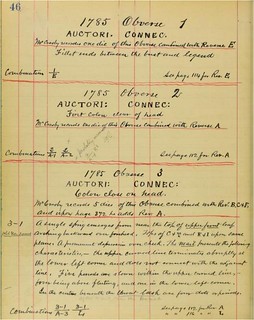 Gathered from the libraries of Dan Hamelberg and Eric P. Newman, the Newman Numismatic Portal has posted a number of manuscripts on Connecticut coppers by Dr. Thomas Hall and others. Connecticut specialists Randy Clark and Robert Martin contributed the following biographical information on Hall:
Gathered from the libraries of Dan Hamelberg and Eric P. Newman, the Newman Numismatic Portal has posted a number of manuscripts on Connecticut coppers by Dr. Thomas Hall and others. Connecticut specialists Randy Clark and Robert Martin contributed the following biographical information on Hall:
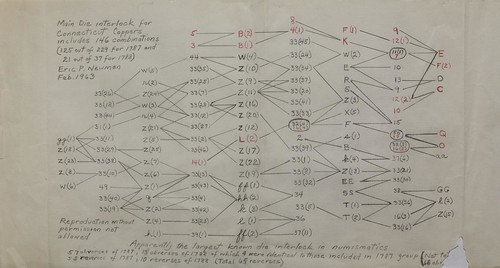
Eric Newman’s die interlock chart for Connecticut coppers (1963)
https://archive.org/details/coinsofconnectic1895hall
https://archive.org/details/drhallmanuscript0000drha
https://archive.org/details/connecticutcents1787hall
https://archive.org/details/inventoryofhallc0000john
https://archive.org/details/main_die_interlock
PNG CALLS FOR 2016 AWARD NOMINATIONS
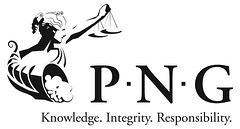 Lifetime Achievement Award:
Lifetime Achievement Award:
Presented to a numismatist for his/her extraordinary devotion to numismatics and who, over their lifetime, significantly contributed to the hobby or profession. Committee Co-Chairs: Dana S. Samuelson and Barry Stuppler. Emails: dana@amergold.com and barry@stuppler.com.
Presented to an author in recognition for an outstanding book or other literature. Named in honor of a publisher and author of numismatic reference books, this award is not automatically given each year. It is only given when there is deemed to be a worthy recipient or recipients. Committee Chair: James A. Simek. Email: nge3@comcast.net. Note: A copy of each book nominated for this year's award must be submitted for delivery no later than June 24, 2016 to James A. Simek, P.O. Box 7157, Westchester, IL 60154-7157.
PNG Calls For 2016 Award Nominations
(www.pngdealers.org/news-releases/item/191-png-calls-for-2016-award-nominations)
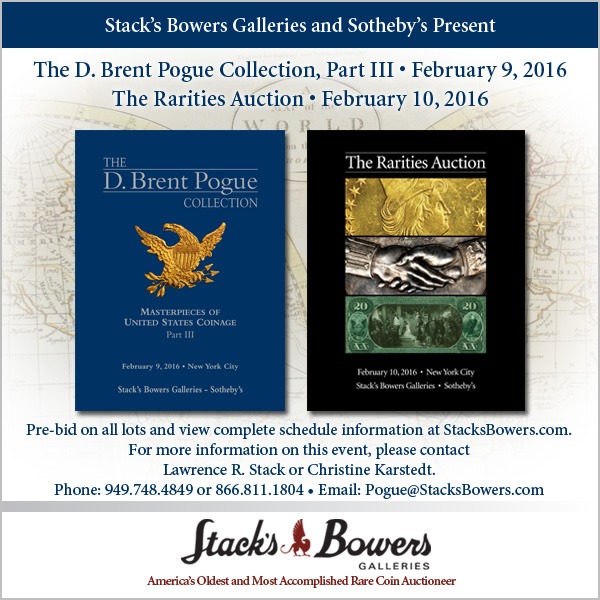
VIRGIL BRAND ESTATE TOKENS AND MEDALS FOUND
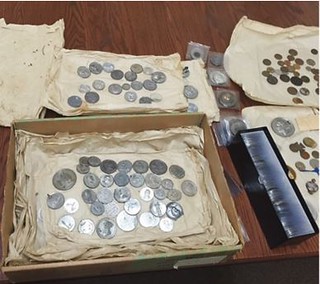

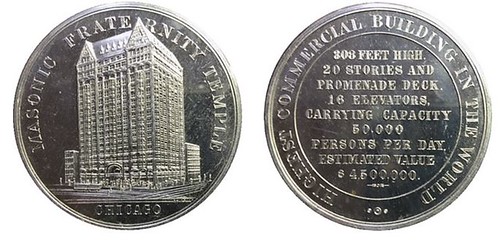
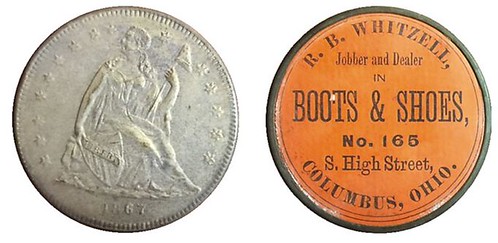
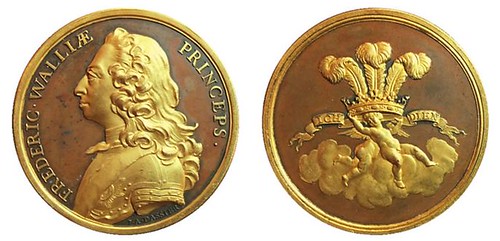
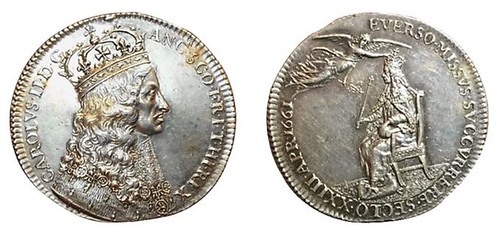
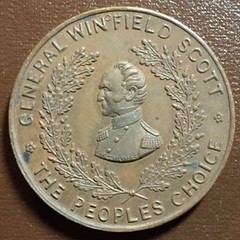
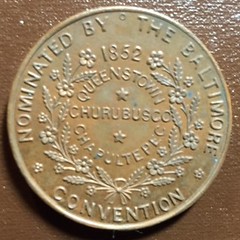
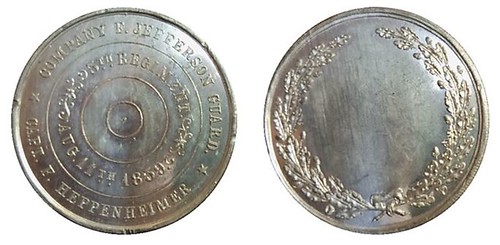
Chicago Coin Company acquires hoard of Virgil M. Brand pedigreed tokens and medals
(www.coinworld.com/news/us-coins/2016/01/last-of-virgil-brand-numismatic-items-in-crates.all.html)
DONN PEARLMAN ON THE WALTON NICKEL RE-DISCOVERY
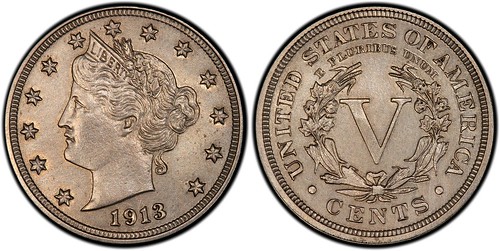
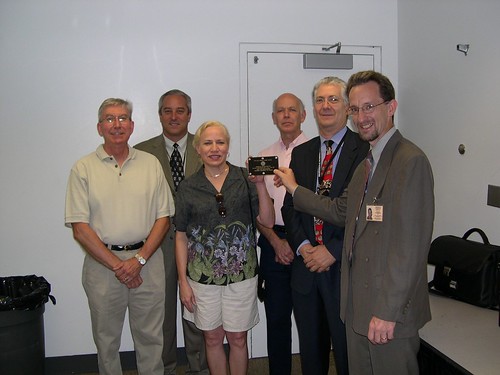

VIDEO: REDISCOVERY OF THE WALTON 1913 LIBERTY NICKEL
(www.coinbooks.org/esylum_v19n03a11.html)

NOTES FROM E-SYLUM READERS: JANUARY 24, 2016
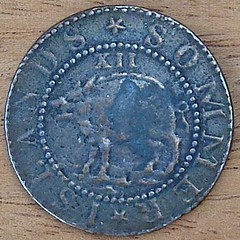
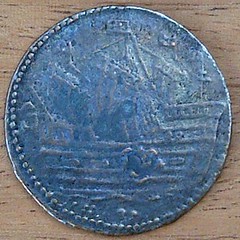
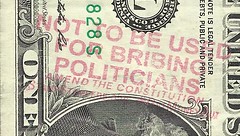 Bob Fritsch writes:
Bob Fritsch writes:
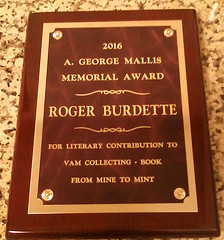 Congratulations to Roger Burdette for winning the 2016 George Mallis Memorial Award from the Society of Silver Dollar Collectors (SSDC) for literary contribution to VAM collecting for his book From Mint to Mint. 'VAM' refers to Van Allen-Mallis numbers for Morgan Dollar and Peace varieties.
Congratulations to Roger Burdette for winning the 2016 George Mallis Memorial Award from the Society of Silver Dollar Collectors (SSDC) for literary contribution to VAM collecting for his book From Mint to Mint. 'VAM' refers to Van Allen-Mallis numbers for Morgan Dollar and Peace varieties.
INDIAN MINISTER PROPOSES LAW AGAINST MELTING ANCIENT COINS
(www.coinbooks.org/esylum_v19n03a22.html)
FANS WANT DAVID BOWIE ON A U.K. BANKNOTE
(www.coinbooks.org/esylum_v19n03a30.html)
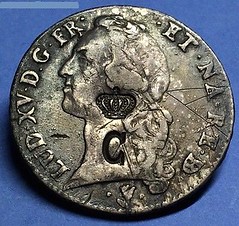
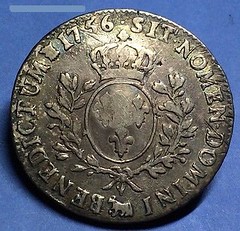

MORE ON THE SKYLAB PLASTER MODELS
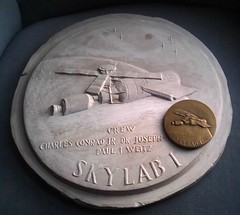

SCOVILL MANUFACTURING EMPLOYEES GRAY BUTLER AND EDWARD DAVIS
(www.coinbooks.org/esylum_v11n14a06.html)
HANDLING AND PRESERVING PLASTER COIN MODELS
(www.coinbooks.org/esylum_v18n46a18.html)
SKYLAB PLASTER MODELS FROM SCULPTOR'S ESTATE
(www.coinbooks.org/esylum_v19n03a18.html)
JAMES "NORMAN" SHULTZ (1893-1988)
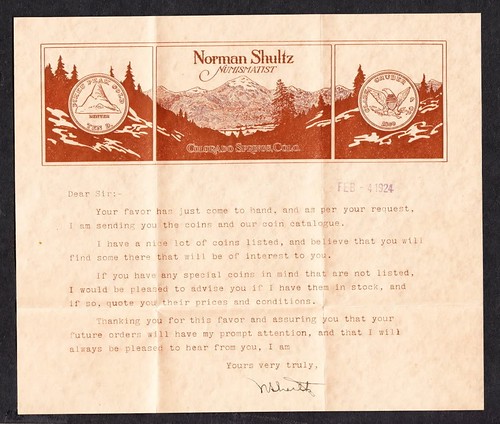
SHULTZ, NORMAN
(https://sites.google.com/site/numismaticmallcom/encyclopedic-dictionary-of-numismatic-biographies/shultz-norman)
THE BOOK BAZARRE
PREDICTING THE NUMISMATIC FUTURE
SIGNS OF RESTORATION AT OLD SAN FRANCISCO MINT
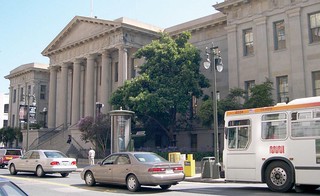 The following paragraph
is excerpted (with the author’s
permission) from John
King’s article, entitled “Blighted
Icon Left to Decay,” which appeared
in the June 28, 2015, edition
of the San Francisco Chronicle:
The following paragraph
is excerpted (with the author’s
permission) from John
King’s article, entitled “Blighted
Icon Left to Decay,” which appeared
in the June 28, 2015, edition
of the San Francisco Chronicle:

Old San Francisco Mint interior (from Henggeler’s site -Editor)
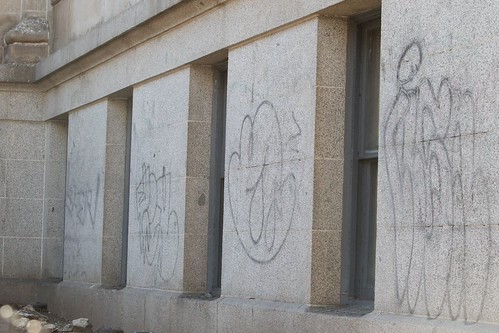
San Francisco’s Old Mint: an endangered icon
(www.sfchronicle.com/bayarea/article/San-Francisco-s-Old-Mint-an-endangered-icon-6352942.php?cmpid=gsa-sfgate-result)
Old Mint to be revived as event space
(www.sfgate.com/bayarea/article/The-Old-Mint-s-disgraceful-state-finally-coming-6708151.php)
OLD SAN FRANCISCO MINT BUILDING ATTRACTS HOMELESS
(www.coinbooks.org/esylum_v18n24a38.html)
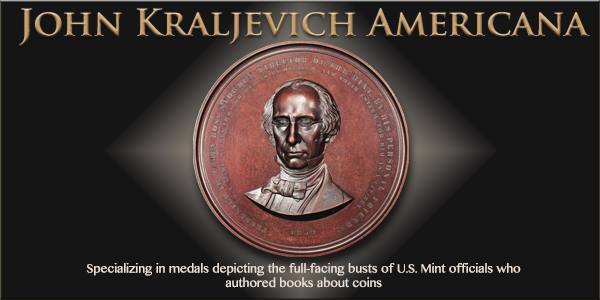
DAVISSONS AUCTION 35 CLOSES FEBRUARY 3, 2016
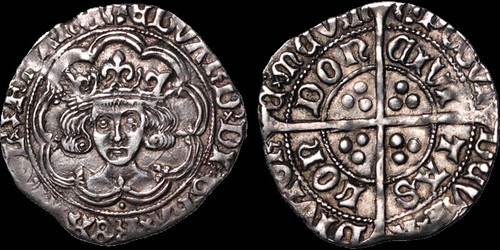
Lot 167

Lot 291
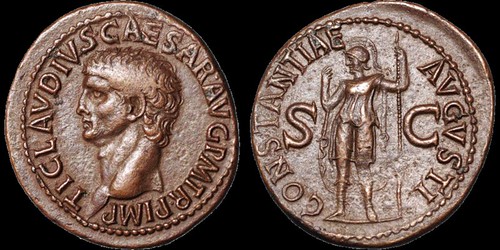
Lot 24
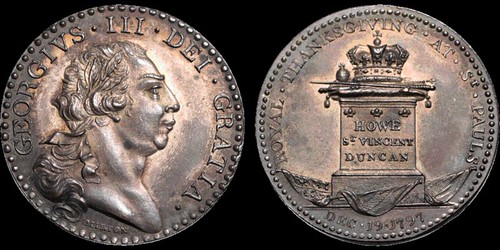
Lot 345
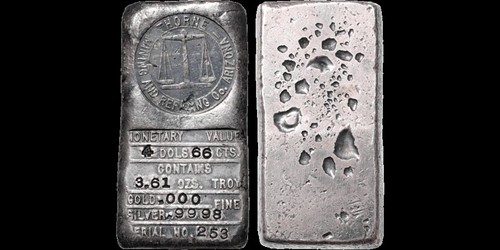
Lot 420
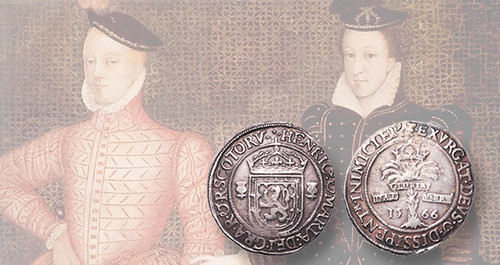
Rare silver ryal of Queen Mary turns up in Davisson auction
(/www.coinworld.com/news/world-coins/2016/01/rare-silver-ryal-of-queen-mary-turns-up-in-davisson-auction.html)
SELECTIONS FROM DAVISSON'S AUCTION 35
(www.coinbooks.org/esylum_v19n03a21.html)
GOLDBERGS OFFER MONEY OF THE BIBLE COLLECTION
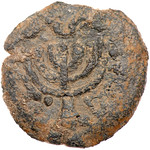 Goldberg Auctioneers Pre-Long Beach Sale, Session Six on February 2, features The Money of the Bible Collection. It kicks off with the fabled Menorah coin, issued by the last Hasmonean (Maccabean) King Mattathias Antigonus c. 37 BCE as he was fighting off Herod, who was backed by the Romans; the Very Fine example is estimated at $45,000-UP.
Goldberg Auctioneers Pre-Long Beach Sale, Session Six on February 2, features The Money of the Bible Collection. It kicks off with the fabled Menorah coin, issued by the last Hasmonean (Maccabean) King Mattathias Antigonus c. 37 BCE as he was fighting off Herod, who was backed by the Romans; the Very Fine example is estimated at $45,000-UP.
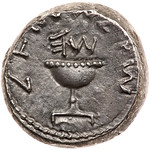 The following lots feature Shekels and Half Shekels issued by the Jews as they fought the Romans in the First Revolt, culminating with the extremely rare Shekel issued in the fifth year (April-August 70 CE). The Year Five Shekel is described as: “Our coin is one of only ten known which share this obverse die, the same die as found on all of the Year 5 shekels excavated at the mountain-top fortress of Masada, thus making a total of only 12 examples from all known dies. Year 5 shekels are the rarest of all the shekels minted during the First Revolt. There were only four months that year to strike them before Titus captured Jerusalem and destroyed the Temple in the Fall of 70 AD. Nevertheless, during the last months of the siege when all commerce as well as the striking of bronze coins came to a halt, it was important to continue striking coins in silver in order for the Jews to continue to pay the half-shekel Temple tax, as commanded in Exodus 30.13. Graded Extremely Fine/Very Fine, it carries an estimate of $125,000-UP.
The following lots feature Shekels and Half Shekels issued by the Jews as they fought the Romans in the First Revolt, culminating with the extremely rare Shekel issued in the fifth year (April-August 70 CE). The Year Five Shekel is described as: “Our coin is one of only ten known which share this obverse die, the same die as found on all of the Year 5 shekels excavated at the mountain-top fortress of Masada, thus making a total of only 12 examples from all known dies. Year 5 shekels are the rarest of all the shekels minted during the First Revolt. There were only four months that year to strike them before Titus captured Jerusalem and destroyed the Temple in the Fall of 70 AD. Nevertheless, during the last months of the siege when all commerce as well as the striking of bronze coins came to a halt, it was important to continue striking coins in silver in order for the Jews to continue to pay the half-shekel Temple tax, as commanded in Exodus 30.13. Graded Extremely Fine/Very Fine, it carries an estimate of $125,000-UP.
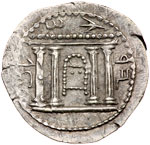 Over 30 silver coins of the Second Revolt (132-135 CE) are featured, including selas (tetradrachms) and zuzim (denarii) from the first, second and third years of the Bar Kochba Revolt. Noteworthy is a Year One Sela described as “incredibly choice example of this major Judean rarity. Boldly struck on a full flan with nice wide margins on both sides. Superb Extremely Fine,” and estimated at $60,000-UP.
Over 30 silver coins of the Second Revolt (132-135 CE) are featured, including selas (tetradrachms) and zuzim (denarii) from the first, second and third years of the Bar Kochba Revolt. Noteworthy is a Year One Sela described as “incredibly choice example of this major Judean rarity. Boldly struck on a full flan with nice wide margins on both sides. Superb Extremely Fine,” and estimated at $60,000-UP.
www.goldbergcoins.com
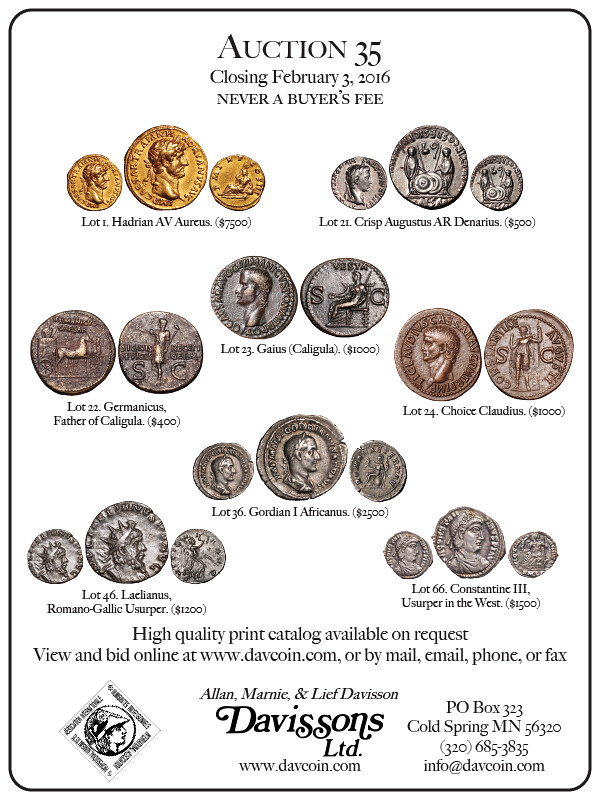
THE TOM REYNOLDS COLLECTION PART I
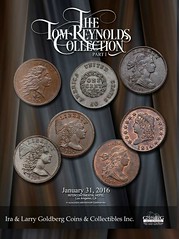 Pat McBride forwarded a link to the online catalog of the Tom Reynolds Collection Part I offered by the Goldbergs January 31, 2016.
Tom's collection of Large Cents is amazing. I saw him often at the Pennsylvania Association of Numismatists shows in Pittsburgh, where he was a regular dealer.
-Editor
Pat McBride forwarded a link to the online catalog of the Tom Reynolds Collection Part I offered by the Goldbergs January 31, 2016.
Tom's collection of Large Cents is amazing. I saw him often at the Pennsylvania Association of Numismatists shows in Pittsburgh, where he was a regular dealer.
-Editor
The Tom Reynolds Collection Part I
(http://issuu.com/goldbergcoins/docs/final_reynoldssm?e=1181641/32473768)
SELECTIONS FROM THE POGUE COLLECTION, PART III
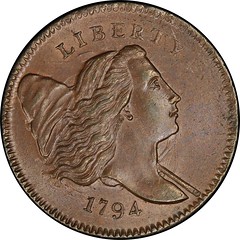
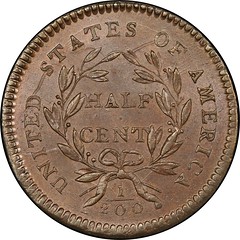
1794 Liberty Cap Half Cent. Cohen-4a. Rarity-3. Small Edge Letters.
(www.stacksbowers.com/BrowseAuctions/LotDetail/
tabid/227/AuctionID/6074/Lot/3003/Default.aspx)
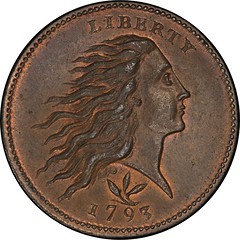
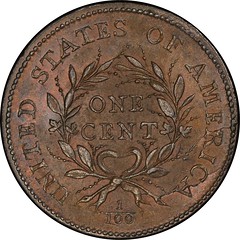
1793 Flowing Hair Cent. Sheldon-9. Rarity-2. Wreath. Vine and Bars Edge.
(www.stacksbowers.com/BrowseAuctions/LotDetail/
tabid/227/AuctionID/6074/Lot/3015/Default.aspx)
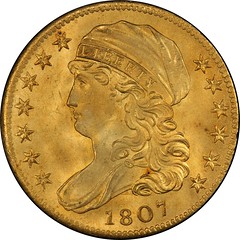

1807 Capped Bust Left Half Eagle. Bass Dannreuther-8. Rarity-2.
(www.stacksbowers.com/BrowseAuctions/LotDetail/
tabid/227/AuctionID/6074/Lot/3132/Default.aspx)
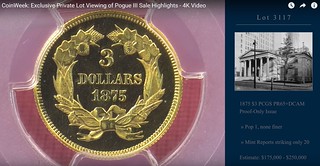
CoinWeek: Exclusive Private Lot Viewing of Pogue III Sale Highlights – 4K Video
(www.coinweek.com/auctions-news/coinweek-exclusive-private-lot-viewing-of-pogue-iii-sale-highlights-4k-video/)
THE BOOK BAZARRE
DNW TO AUCTION RARE EDWARD VIII FANTASY COINS
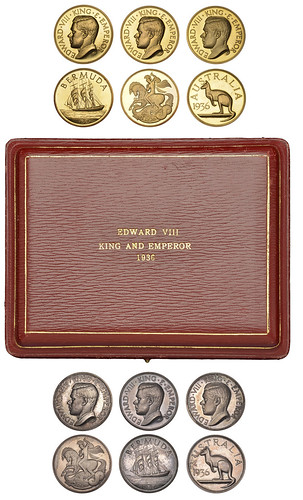 An extremely rare set of Edward VIII fantasy Crowns presented to a key confidant of the King who guided him through the abdication crisis of 1936 is to be auctioned by Dix Noonan Webb, the international coins, medals and jewellery specialists, in London on 21 March 2016. The six Crowns produced by Geoffrey Hearn in 1954 to commemorate Edward’s brief reign are contained in a magnificent presentation case given to the former King’s private solicitor, Sir George Allen.
An extremely rare set of Edward VIII fantasy Crowns presented to a key confidant of the King who guided him through the abdication crisis of 1936 is to be auctioned by Dix Noonan Webb, the international coins, medals and jewellery specialists, in London on 21 March 2016. The six Crowns produced by Geoffrey Hearn in 1954 to commemorate Edward’s brief reign are contained in a magnificent presentation case given to the former King’s private solicitor, Sir George Allen.
www.dnw.co.uk
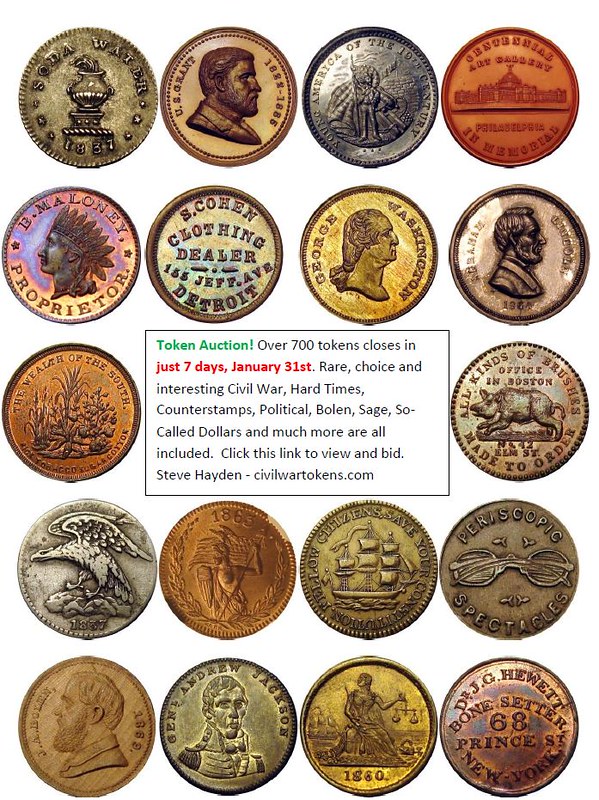
WAYNE'S NUMISMATIC DIARY: JANUARY 24, 2016
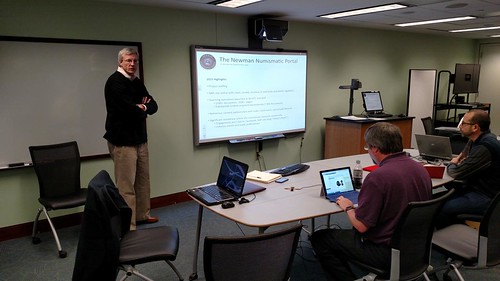
Len Augsburger presenting; Greg Bradley and John Feigenbaum at table
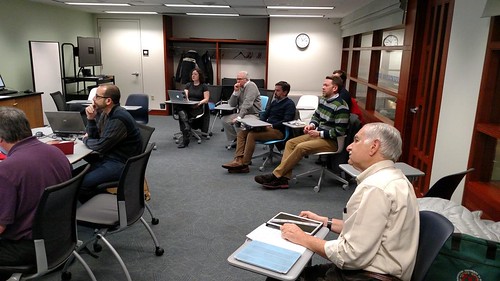
Andy Newman in forground; Greg and John at table; WUSTL Staff in back (Chris Freeland in green sweater)
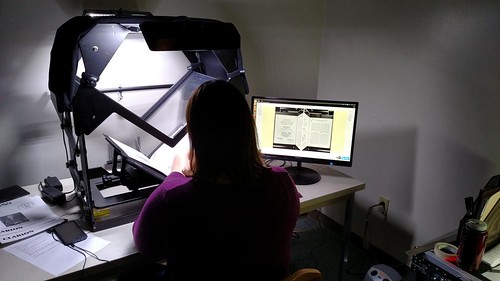
WUSTL student scanning The Clarion
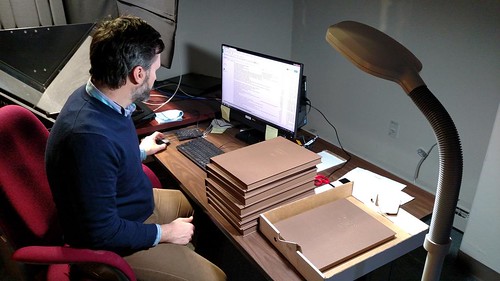
Digitization Manager Robert Manley logging Hamelberg Elder catalogs
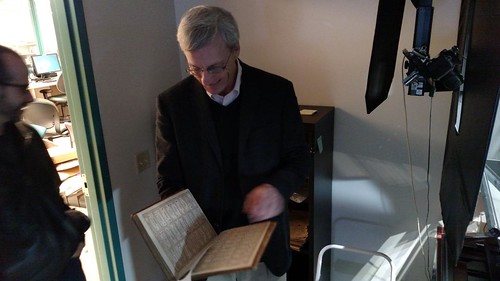
Len Augsburger examining counterfeit detector (Feigenbaum at left)
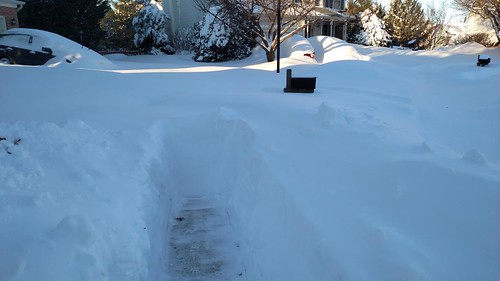
MORE ON LOTTERIES IN COLONIAL AMERICA

Report of a Committee Appointed to Investigate the Evils of Lotteries In the Commonwealth of Pennsylvania, 1831
Curiosities of the Old Lottery by Henry W. Brooks, 1886
The United States Lottery by Lucius Wilmerding, Jr., in The New-York Historical Society Quarterly, January 1963
The Early Lotteries of New Jersey by Harry B. Weiss and Grace M. Weiss, 1966
Pre-Civil War Baltimore Lotteries by Russ Sear, no date
By Chance A Winner: The History of Lotteries by George Sullivan, 1972
One Hundred Years of American Lottery Tickets 1744-1844, a fixed price list (Second Printing, 1988)
I'm sure there are more I haven't acquired yet. This is a fascinating area of Americana made topical by the recent record-breaking Powerball jackpot. I didn't win, but you bet I had a couple tickets!
-Editor
LOTTERIES IN COLONIAL AMERICA
(www.coinbooks.org/esylum_v19n03a16.html)
THE NUMISMATICS OF PROFESSIONAL BOXING

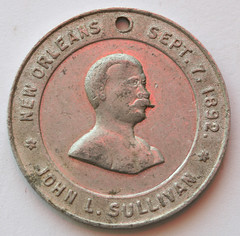
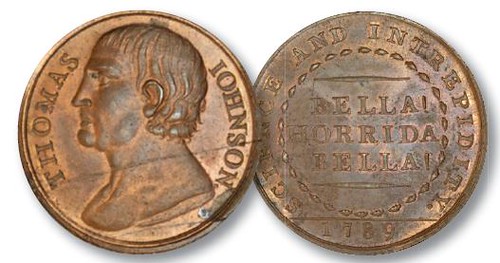
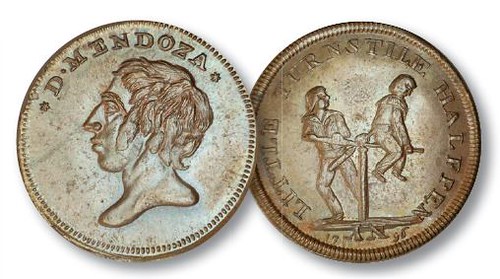
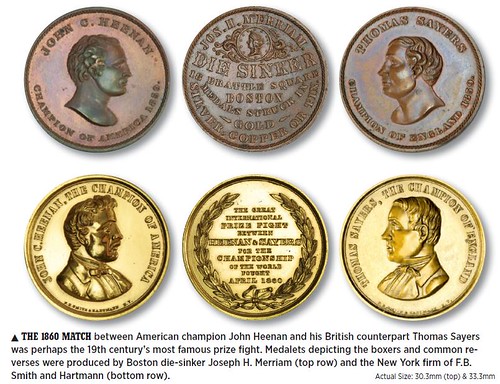
www.money.org
NOTES FROM E-SYLUM READERS: JANUARY 10, 2016 : Boxer John L. Sullivan
(www.coinbooks.org/esylum_v19n02a12.html)

1916 IRISH EASTER RISING ANNIVERSARY MEDAL SOLD
 50-year-old gold coin depicting Pádraig Pearse, one of the leaders of the 1916 Easter Rising, has been sold at an auction house in North Belfast for more than £3,000.
50-year-old gold coin depicting Pádraig Pearse, one of the leaders of the 1916 Easter Rising, has been sold at an auction house in North Belfast for more than £3,000.
Sellers thought solid gold 1916 coin was brass
(http://belfastmediagroup.com/sellers-thought-solid-gold-1916-coin-was-brass/)
STRANGE ERROR: ROOSEVELT DIME STRUCK ON A NAIL
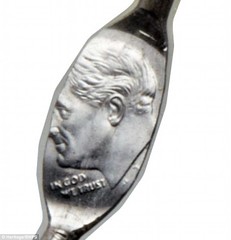 A unique coin struck on a rogue nail in a spectacular minting error has sold for more than $42,000.
A unique coin struck on a rogue nail in a spectacular minting error has sold for more than $42,000.
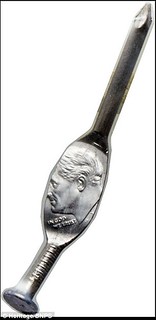
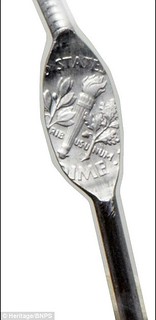
Dime that's worth a mint! Rogue nail which was accidentally turned into a coin sells for $42,000
(www.dailymail.co.uk/news/article-3406355/Dime-s-worth-mint-Rogue-nail-accidentally-turned-coin-sells-42-000.html)
THE BOOK BAZARRE
POET ROBERT BURNS ON SCOTLAND’S FIRST POLYMER BANKNOTE
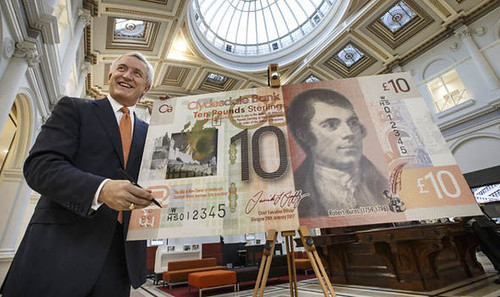
Robert Burns on new bank note
(www.express.co.uk/scotland/637224/Robert-Burns-on-new-bank-note)
VIETNAMESE BUY SPECIAL BANKNOTES FOR TET
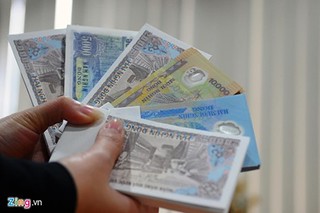 Currency exchange shops are busier than ever as the Tet (Lunar New Year) nears. With such demand, the likelihood of overcharging customers increases.
Currency exchange shops are busier than ever as the Tet (Lunar New Year) nears. With such demand, the likelihood of overcharging customers increases.
Money changers up prices for Tet holiday
(http://vietnamnews.vn/life-style/281369/money-changers-up-prices-for-tet-holiday.html)

BIBLIOGRAPHY WEEK 2016
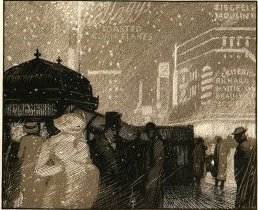 JANUARY 25-30 IS BIBLIOGRAPHY WEEK. "Bibliography Week" happens each year in New York City at the end of January when the principal national organizations devoted to book history have their annual meetings. Other groups plan interesting events, too, since so many bibliophiles are in town. Some events are open to members only, but mostly you are encouraged to show up everywhere: get a sense of what is going on in the book world, hear some interesting papers, schmooze over cocktails...
JANUARY 25-30 IS BIBLIOGRAPHY WEEK. "Bibliography Week" happens each year in New York City at the end of January when the principal national organizations devoted to book history have their annual meetings. Other groups plan interesting events, too, since so many bibliophiles are in town. Some events are open to members only, but mostly you are encouraged to show up everywhere: get a sense of what is going on in the book world, hear some interesting papers, schmooze over cocktails...
• 2:00 pm-7:00 pm. At the Grolier Club: Collecting Symposium. Held in connection with “The Grolier Club Collects II,” this half-day symposium brings together The Grolier Club, the Harry Ransom Center, and the New York Public Library to celebrate the book-collecting legacy of Carl H. Pforzheimer (1879–1957).
• 2:30 pm-3:30 pm. At the Grolier Club: Bibliography Week lecture, with Arthur Schwarz offering “Curator’s Choice,” in connection with “The Grolier Club Collects II” exhibition.
• 2:00 pm-7:00 pm. At the Cosmopolitan Club, 122 E 66th Street (Park and Lexington): The annual meeting of the Bibliographical Society of America. Papers from New Scholars at 2 pm, Annual meeting at 4 pm, with address to follow. This year's guest speaker is Michael F. Suarez, S.J., on "Hard Cases: Confronting Bibliographical Difficulty in Eighteenth-Century Texts.” Reception follows at 6 pm.
Bibliography Week 2016
January 25-30, 2016: Preliminary Schedule of Events
(www.grolierclub.org/Default.aspx?p=DynamicModule&pageid=289376&ssid=168769&vnf=1)
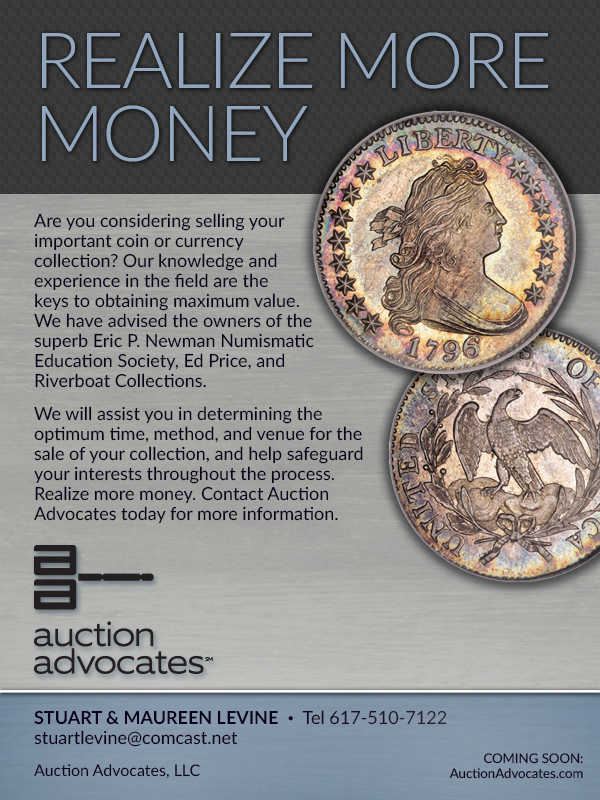
CHANGING ROLE OF LIBRARIANS IN THE INTERNET AGE
The comments following the article are interesting and worth a read. Here are a few.
-Editor
The Internet opened worlds, quick answers, and fast access, but it is one of many tools in research. If you need to check facts or add more depth, librarians provide additional sources: museums, local history, databases, books, and persons.
Google and other online sources provide only unvetted opinion and are useful to people who want answers in ten words or less. Libraries, on the other hand are staffed by scholars who are well versed in their academic fields. These scholars search for books (sources of information both pro and con) and carefully verify (vet) the information therein as valid.
Technology has changed many jobs over the years. Those that fail to adopt the technology and transform their work by incorporating it are left behind. Today's librarians, and there are many still coming out of grad schools, are information specialists that help organize and protect information assets as well as bring new learning opportunities to their communities that are information and experience based. The future librarian will not look like that of our past but will surely be there to help guide our future. This article is too focused on the past and lacks insight to the changes going on at leading colleges and universities and why these changes are important to a society inundated with much garbage on the internet.
In Age of Google, Librarians Get Shelved
(www.wsj.com/articles/in-age-of-google-librarians-get-shelved-1452461659?cb=logged0.4460955150425434)
THE BOOK BAZARRE
Paper Money of the U.S., Friedberg, 19th ed., COLOR images, FREE SHIP, $25
THE CALIFORNIA GOLD RUSH BEGAN JANUARY 24, 1848
http://writersalmanac.org/episodes/20160124/
THE BOOK BAZARRE
FEATURED WEB SITE: INTERNATIONAL BANK NOTE SOCIETY
This week's Featured Web Site is the International Bank Note Society (IBNS).
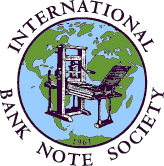
www.theibns.org

